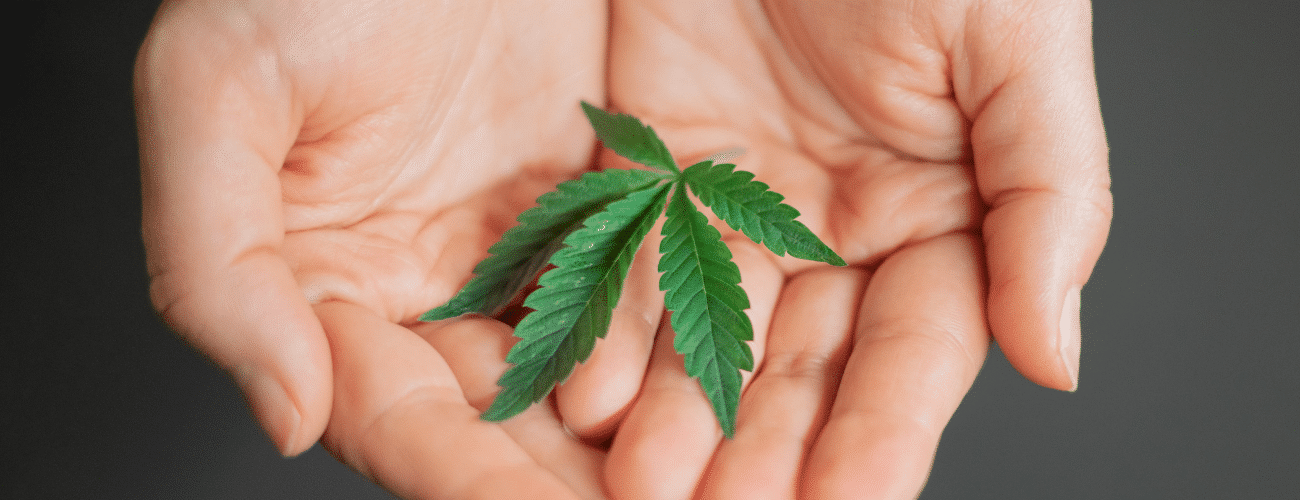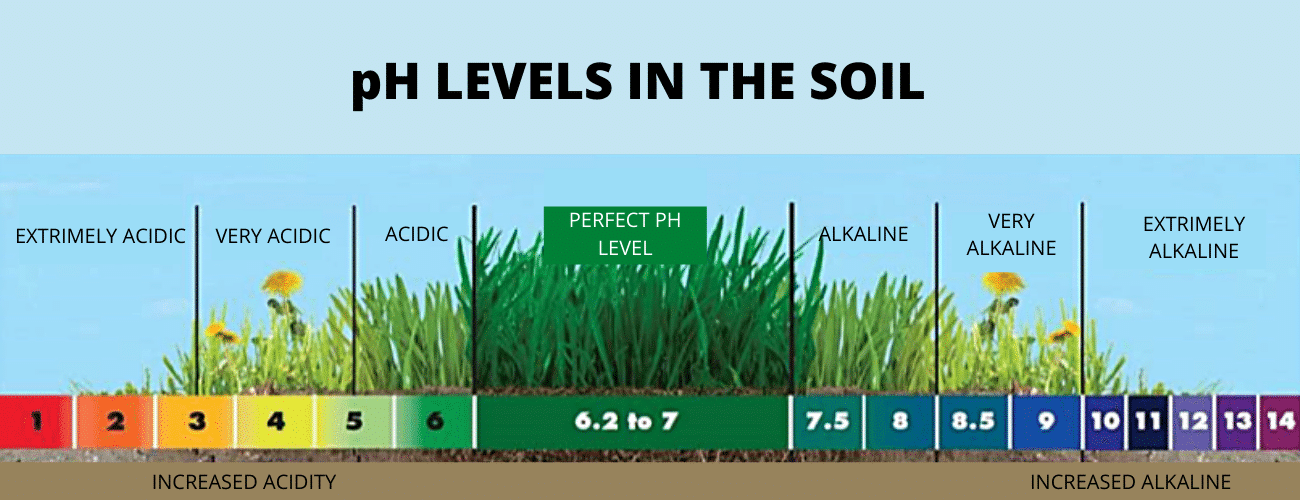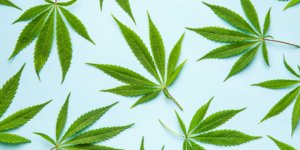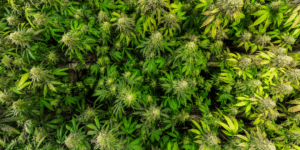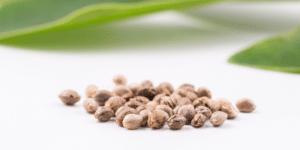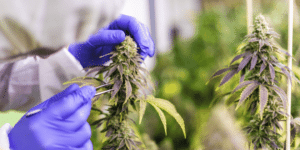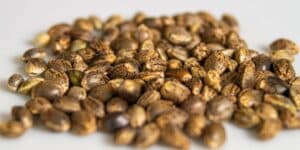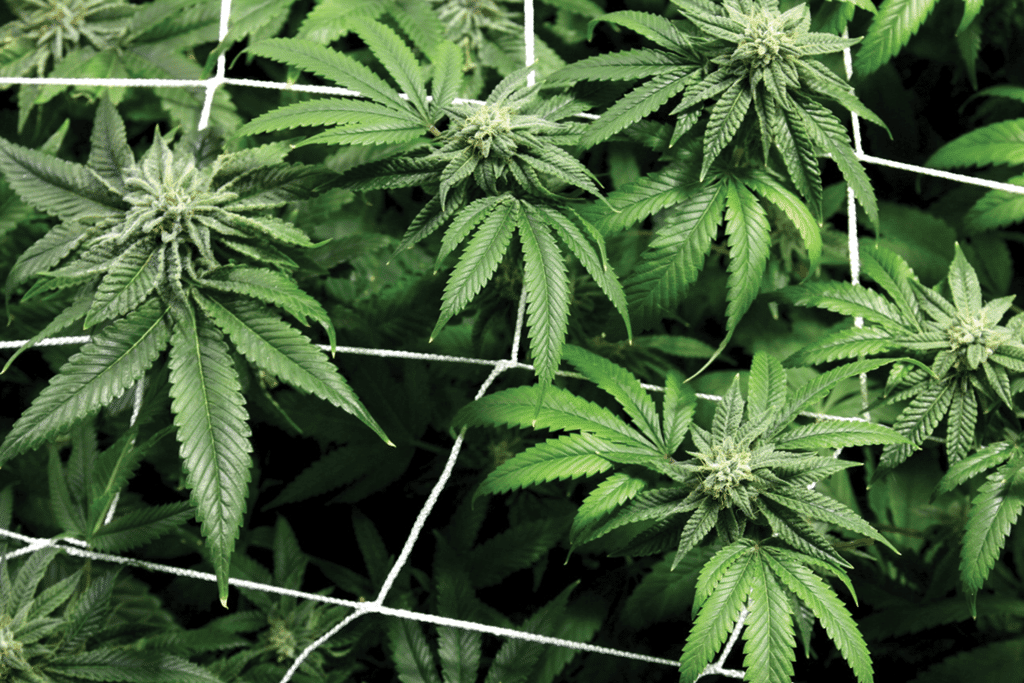Cultivation
Deficiencies Guide [Leaves, Nutrients & Charts Explained]!
เมื่อพูดถึงการปลูกกัญชาหรืออะไรก็ตามจริงๆแล้วทุกคนมักจะตามล่าหาความลับที่ยิ่งใหญ่อย่างหนึ่งสู่ความสําเร็จ แม้ว่าเราจะเกลียดที่จะทําให้คุณผิดหวัง แต่ความจริงก็คือไม่มีความลับเพียงอย่างเดียว แต่เป็นชุดของหลักการที่หากปฏิบัติตามสามารถช่วยให้คุณปลูกต้นกัญชาที่สวยงามและมีสุขภาพดีได้
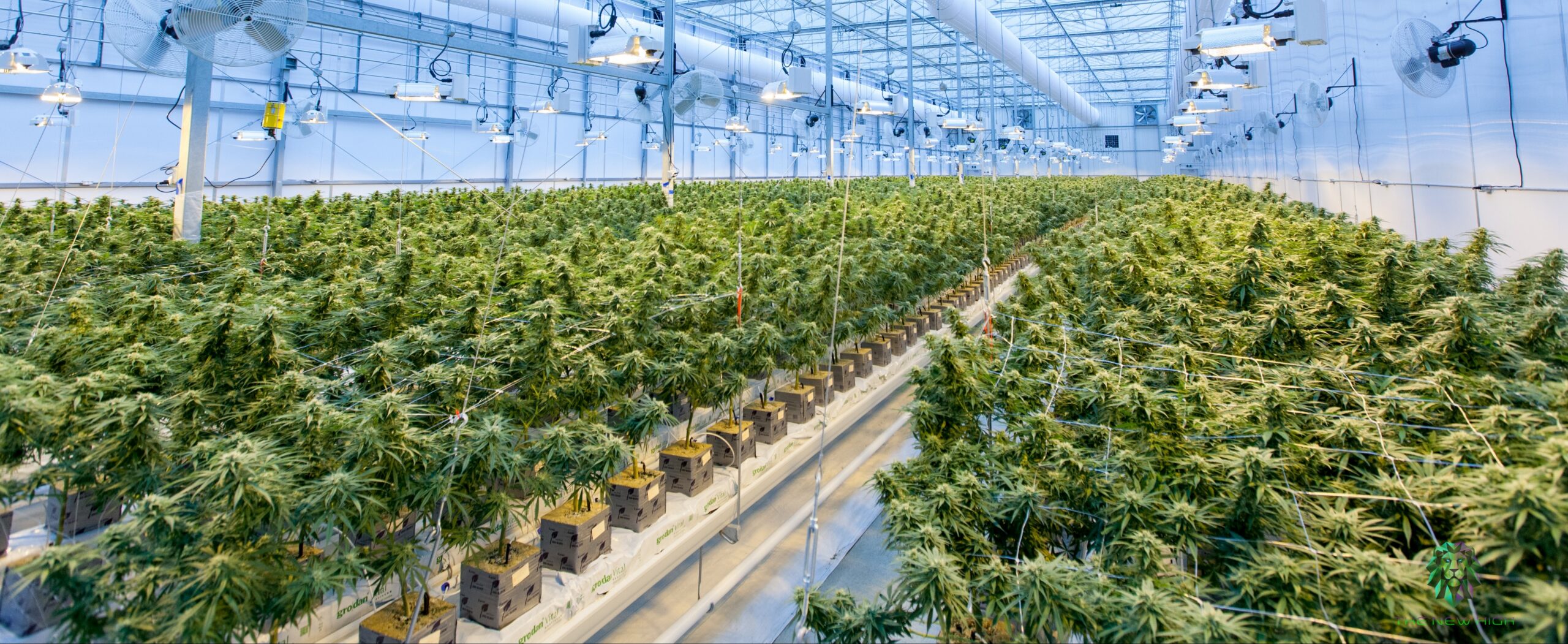
ในการเริ่มต้นคุณต้องจําไว้ว่าพืชกัญชามีความเฉพาะเจาะจงมากเกี่ยวกับสภาพแวดล้อมของพวกเขา ในการปลูกพืชกัญชาให้ประสบความสําเร็จ, คุณต้องเข้าใจอุณหภูมิในอุดมคติ, ระดับความชื้น, ปริมาณแสง, และอาหารที่อุดมไปด้วยสารอาหารที่พืชของคุณต้องการเพื่อเจริญเติบโต.
เช่นเดียวกับมนุษย์พืชต้องการบางสิ่งเพื่อความอยู่รอดและเจริญเติบโต หากมีบางสิ่งที่ขาดหายไปจากสภาพแวดล้อมของพืชกัญชาของคุณข้อบกพร่องเหล่านี้จะสะท้อนให้เห็นในวิธีที่มันเติบโต การขาดเป็นเวลานานอาจทําให้เกิดความเครียดในพืชของคุณ (ใช่พืชก็เครียดเช่นกัน) ความเครียดนี้จะทําให้มีความอ่อนไหวต่อปัจจัยยับยั้งการเจริญเติบโตหลายอย่างเช่นแมลงและแมลงศัตรูพืชเชื้อราโรคและปัญหาที่ยุ่งยาก
เมื่อคุณเรียนรู้ที่จะมองเห็นสัญญาณและอาการของข้อบกพร่องต่าง ๆ, คุณจะสามารถแก้ไขสถานการณ์และปรับปรุงสุขภาพของพืชของคุณ. อ่านต่อเพื่อเรียนรู้เพิ่มเติมเกี่ยวกับการขาดสารอาหารทั่วไปเคล็ดลับในการแก้ไขข้อบกพร่องที่มีอยู่และวิธีป้องกันตั้งแต่แรก
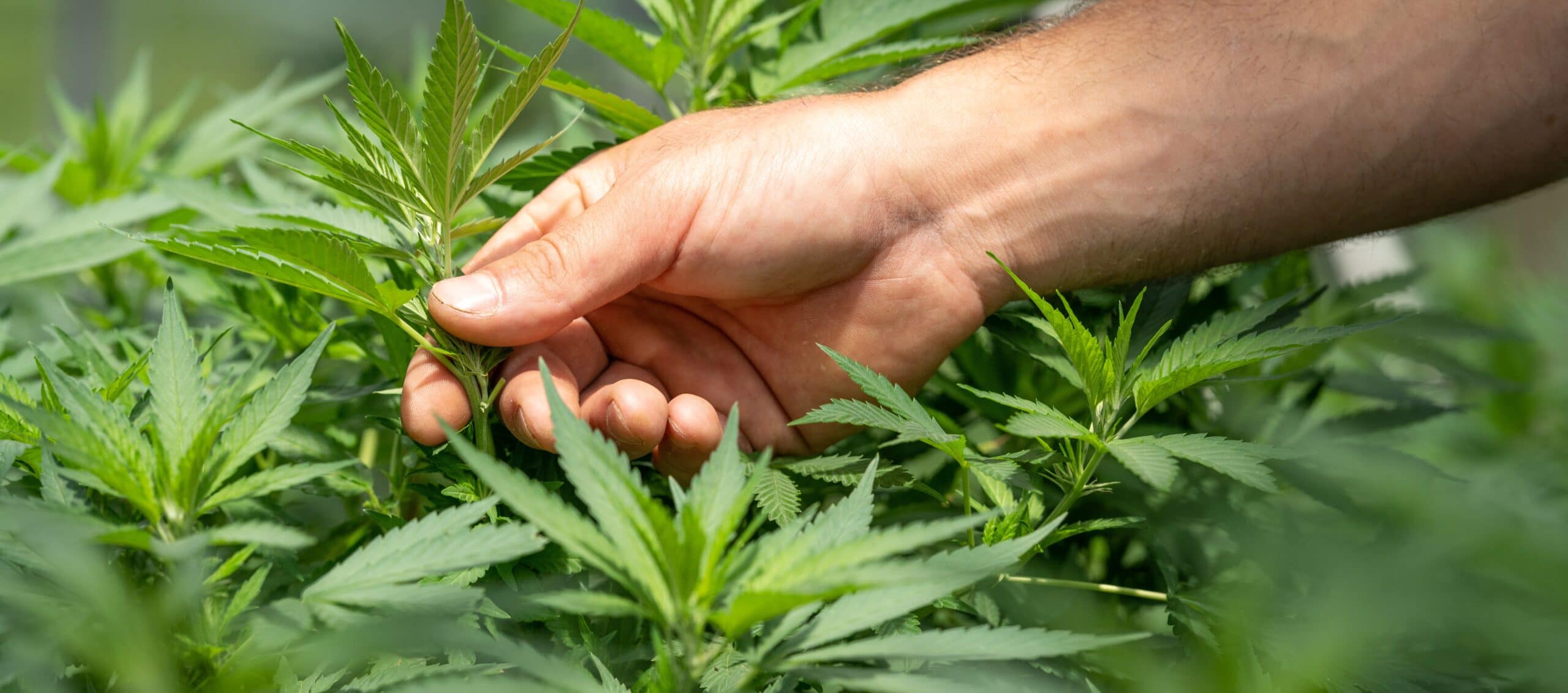
เนื้อหา
การขาดกัญชาคืออะไร?
คุณเคยได้ยินเกี่ยวกับมนุษย์ที่มีการขาดวิตามินหรือแร่ธาตุหรือไม่? ปรากฎว่าพืชของคุณสามารถทนทุกข์ทรมานจากสิ่งเดียวกัน สิ่งมีชีวิตทั้งหมดต้องการชุดของสารอาหารที่พวกเขาต้องการในการทํางานและเติบโตอย่างที่ควรจะเป็นและเมื่อมีบางสิ่งขาดหายไปมันอาจมีผลอย่างมาก
เมื่อพูดถึงพืชกัญชาข้อบกพร่องเหล่านี้สามารถประจักษ์ ในระดับที่ลดลงของ THC และปริมาณของผลผลิต cannabinoid / terpene ในบางกรณีมันสามารถฆ่าพืชกัญชาของคุณได้หากคุณไม่ได้แก้ไขปัญหาได้ทันเวลา
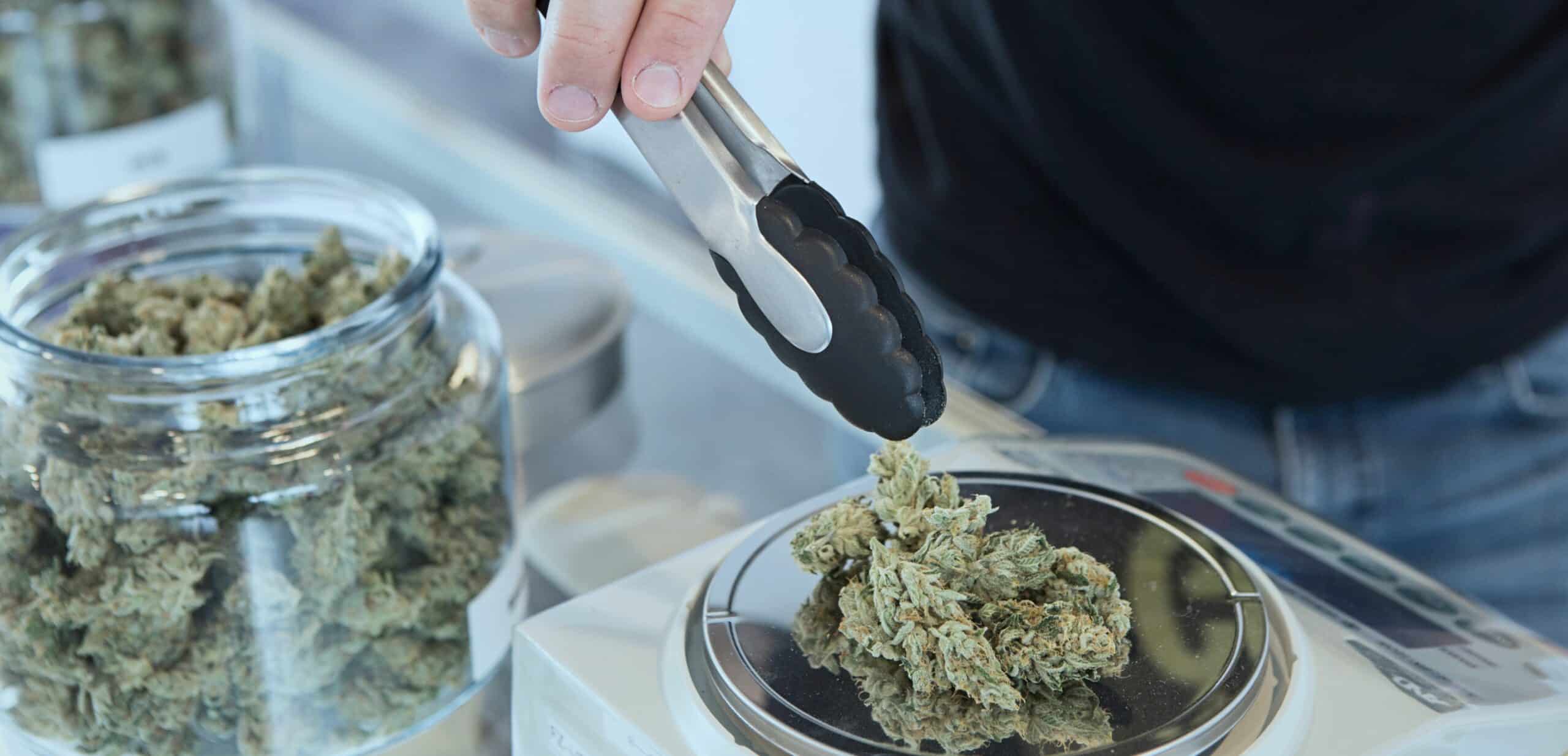
ข้อมูลนี้อาจรู้สึกท่วมท้นเล็กน้อยในครั้งแรกที่คุณเรียนรู้ แต่อย่าท้อแท้! ข่าวดีก็คือว่าแม้ว่าจะมีหลายสิ่งหลายอย่าง (หรือขาดสิ่ง, เพื่อความแม่นยํา), ที่อาจทําให้เกิดข้อบกพร่อง, แต่ละประเภทของการขาดมีอาการเฉพาะสวยที่คุณสามารถระบุได้ถ้าคุณรู้ว่าสิ่งที่จะมองหา.
อาการและอาการแสดงเหล่านี้สามารถประจักษ์ในการเปลี่ยนแปลงใบลักษณะโดยรวมของพืชและสัญญาณภาพอื่น ๆ ที่เราจะร่างไว้ด้านล่าง
ระดับ Ph & แผนภูมิสารอาหารกัญชา
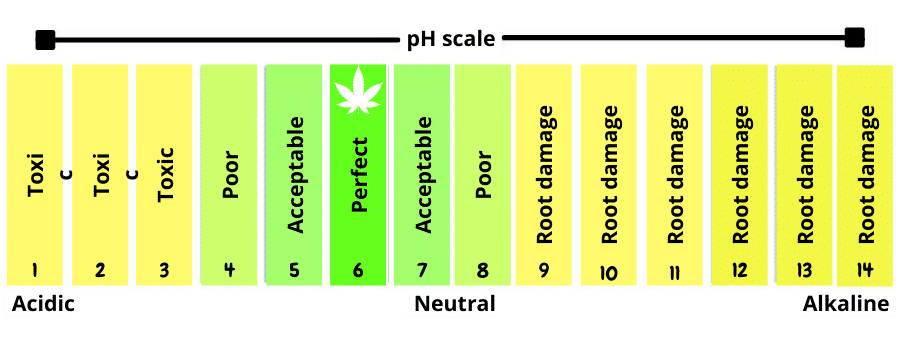
ระดับ PH สําหรับกัญชา
น่าเสียดายที่การตรวจสอบให้แน่ใจว่าพืชของคุณได้รับสารอาหารทั้งหมดที่ต้องการนั้นไม่ได้ขึ้นอยู่กับอาหารที่คุณให้เท่านั้น คุณสามารถมีอาหารที่อุดมด้วยสารอาหารที่สมดุลอย่างสมบูรณ์แบบที่สุดทั่วโลก แต่พืชของคุณ ยังสามารถ ขาดสารอาหารได้ พูดคุยเกี่ยวกับความผิดหวัง! เหตุผลที่สิ่งนี้เกิดขึ้นคืออาหารเป็นเพียงส่วนหนึ่งของภาพ สิ่งอื่น ๆ ที่ควรพิจารณาคือพืชของคุณสามารถดูดซับสารอาหารที่คุณพยายามจะให้ได้อย่างไร ที่น่าประหลาดใจของหลาย ๆ คนการดูดซึมสารอาหารขึ้นอยู่กับระดับ pH ของดินเป็นหลัก เพื่อให้พืชกัญชาของคุณดูดซับสารอาหารเหล่านั้นระดับ pH ของดิน จะต้อง อยู่ในช่วงที่กําหนด ดินที่เป็นด่างหรือเป็นกรดมากเกินไปจะปิดกั้นรากของพืชของคุณจากการดูดซับสารอาหารใด ๆ
เนื่องจากค่า pH ของดินเป็นเหมือนผู้รักษาประตูสารอาหารสําหรับพืชกัญชาของคุณคุณควรตรวจสอบระดับ pH ก่อน ตรวจสอบการขาดสารอาหารอื่น ๆ แม้ว่าพืชของคุณจะขาดสารอาหารที่กําหนด แต่ก็อาจเป็นเพราะคุณต้องปรับระดับ pH ของดินของคุณ
ตามหลักการแล้วระดับ pH ของดินของคุณหรือตัวกลางที่กําลังเติบโตอื่น ๆ ควรอยู่ระหว่าง 5.8-8-6.8 ค่าในอุดมคติอยู่ที่ประมาณ 6.3 แต่ถ้าค่า pH ของคุณอยู่ระหว่างช่วงนั้น ก็ควรเป็นที่ยอมรับและมีแนวโน้มว่าจะไม่ป้องกันไม่ให้รากของคุณดูดซับสารอาหาร โดยทั่วไป ค่า pH ของดิน (หรือทางเลือกอื่น) ของคุณควรควบคุมตนเองให้อยู่ในระดับ pH ที่ถูกต้อง แต่ปัจจัยบางอย่าง เช่น ค่า pH ของน้ําอาจมีผลต่อการตกนอกช่วงที่ต้องการ
น้ําทําให้เกิดข้อบกพร่อง
หนึ่งในสารอาหารมากมายสําหรับพืชของคุณคือน้ําที่คุณใช้เพื่อให้ความชุ่มชื้นแก่พวกมัน หากคุณใช้น้ําฝนน้ําจมหรือสิ่งที่คล้ายกันอาจเป็นไปได้ว่าน้ําของคุณมีแร่ธาตุสูง แต่ต่ําในแร่ธาตุอื่น ๆ เนื่องจากผู้ปลูกกัญชาจํานวนมากใช้อาหารจากพืชเฉพาะเพื่อตรวจสอบและควบคุมระดับสารอาหารของพืชของพวกเขาแร่ธาตุเพิ่มเติมจากแหล่งน้ําของคุณอาจมองข้ามไป นี้อาจทําให้เกิดความไม่สมดุลที่อาจส่งผลให้เกิดการขาดหรือคล้ายกับหนึ่ง.
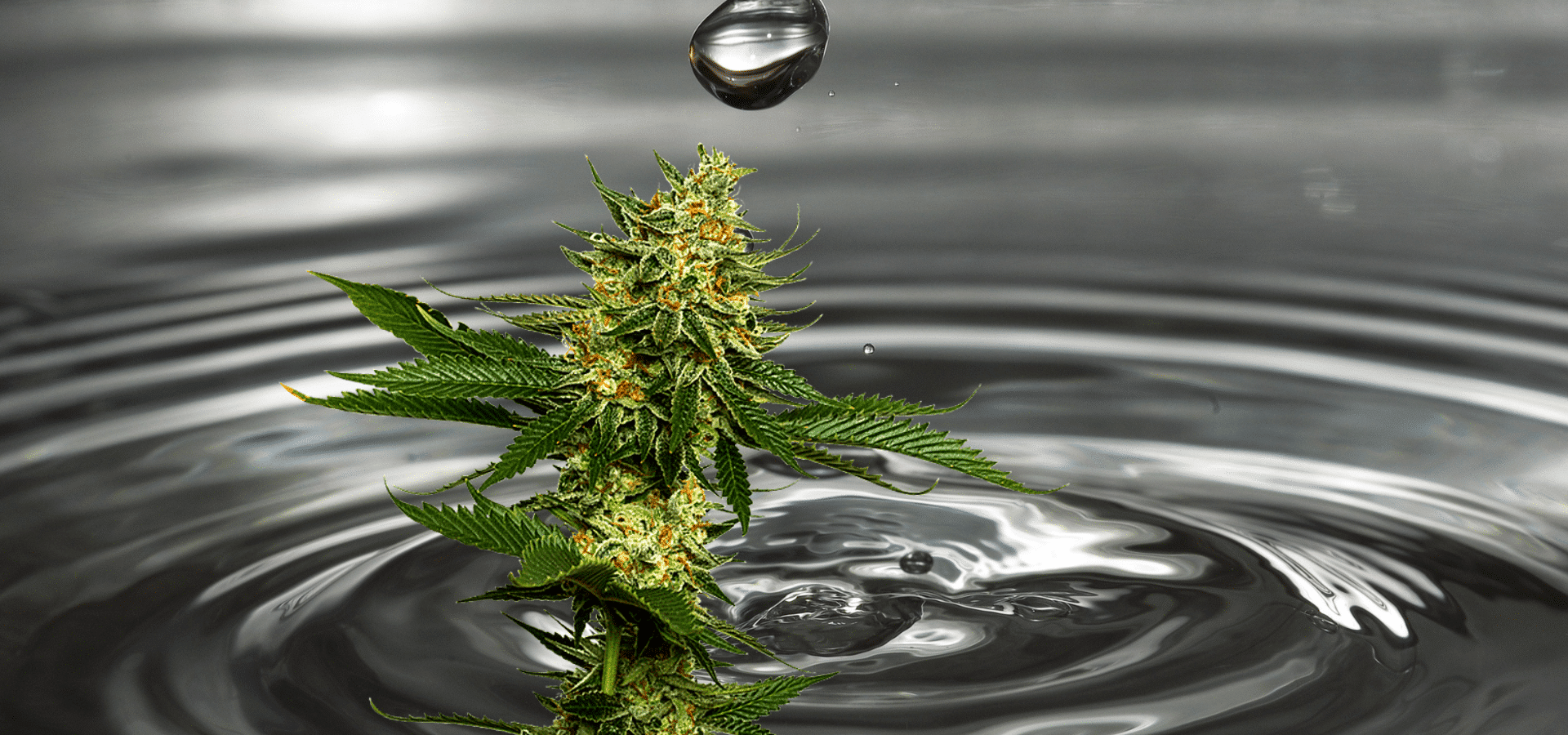
หนึ่งในเคล็ดลับที่ดีที่สุดในการหลีกเลี่ยงผลลัพธ์นี้คือการควบคุมน้ําที่คุณใช้สําหรับพืชกัญชาของคุณอย่างเข้มงวด มันค่อนข้างมีชื่อเสียงสําหรับผู้ปลูกโดยเฉพาะการใช้น้ําปราศจากไอออน (น้ําที่มีการกําจัดไอออนทั้งหมด) น้ําปราศจากไอออนปราศจากแร่ธาตุจากน้ําที่อาจรบกวนความสมดุลของสารอาหารที่ละเอียดอ่อนที่พืชกัญชาของคุณต้องการเพื่อความอยู่รอด ขั้นตอนนี้ไม่จําเป็นอย่างเคร่งครัด แต่ถ้าแหล่งน้ําในพื้นที่ของคุณอุดมไปด้วยแร่ธาตุมากอาจเป็นการดีที่จะเปลี่ยนไปใช้น้ําปราศจากไอออนแทน
ธาตุอาหารหลักและการขาดสารอาหารรอง
ธาตุอาหารหลัก เป็นสารอาหารที่พืชกัญชาของคุณต้องได้รับในปริมาณ มาก ในทํานองเดียวกันมนุษย์ต้องการไขมันคาร์โบไฮเดรตและโปรตีน พืชต้องการไนโตรเจนฟอสฟอรัสและโพแทสเซียมเป็นต้น ธาตุอาหารหลักเหล่านี้มีความจําเป็นสําหรับการเจริญเติบโตของพืชที่มีสุขภาพดีและพวกเขารู้สึกว่ากระบวนการทางชีวเคมีหลักส่วนใหญ่ที่เกิดขึ้นระหว่างการพัฒนาและเบ่งบาน
สารอาหารรอง มีความจําเป็นในปริมาณที่น้อยกว่ามาก แต่มีความจําเป็นเหมือนกันทั้งหมด สารอาหารเหล่านี้, รวมทั้งซิลิกอน, สังกะสี, ทองแดง, และกํามะถัน, ช่วยด้วยการทํางานทางชีวภาพของเซลล์ของพืช.
สารอาหารเคลื่อนที่เทียบกับสารอาหารที่เคลื่อนที่ไม่ได้
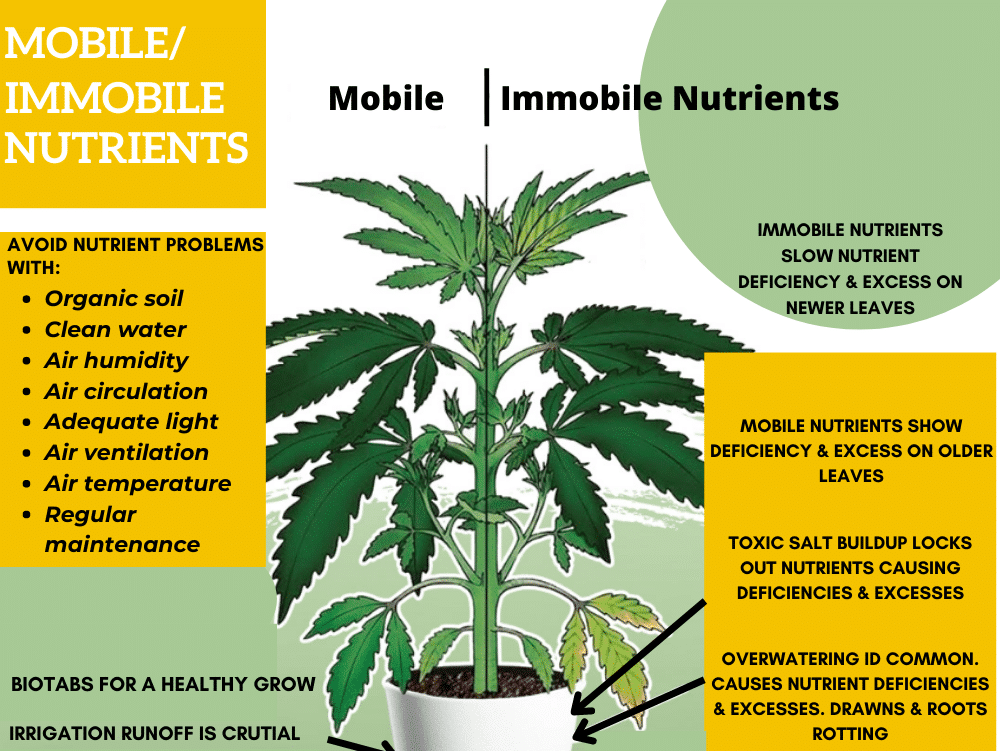
นอกจากมาโครและสารอาหารรองแล้วพืชกัญชาของคุณยังมีสารอาหารอีกสองประเภท (และต้องการ) : มือถือและไม่เคลื่อนที่ได้
ตามชื่อที่แนะนํา สารอาหารเคลื่อนที่ สามารถเคลื่อนที่ไปทั่วพืชได้หากจําเป็น ในทางกลับกันสารอาหารที่เคลื่อนที่ไม่ได้ จะไม่สามารถเคลื่อนไหวได้เมื่อพืชสะสมไว้
เมื่อคุณเผชิญกับการขาดสารอาหารมือถือคุณจะสามารถสังเกตเห็นได้ง่ายที่สุดใน การเจริญเติบโตของพืชเก่า นี่เป็นเพราะพืชจะจัดลําดับความสําคัญของการเจริญเติบโตใหม่และหากต้องเผชิญกับการขาดสารอาหารมือถือจะดูดสารอาหารออกจากส่วนที่เก่ากว่าของพืชและเข้าสู่ชิ้นล่าสุด ตัวอย่างทั่วไปของสารอาหารเคลื่อนที่ ได้แก่ แมกนีเซียม ฟอสฟอรัส ไนโตรเจน โพแทสเซียม และนิกเกิล
การขาดสารอาหารที่เคลื่อนที่ไม่ได้นําเสนอปัญหาตรงกันข้าม สารอาหารเหล่านี้ถูกผูกติดอยู่กับบางส่วนของพืชดังนั้นหากการขาดสารอาหารเกิดขึ้นในระหว่างการเจริญเติบโตใหม่นั่นคือที่ที่คุณจะสังเกตเห็นอาการของการขาดสารอาหารที่ไม่สามารถเคลื่อนที่ได้ (แต่การเจริญเติบโตของเก่าจะดูดี) สารอาหารที่ไม่สามารถเคลื่อนที่ได้ทั่วไป ได้แก่ แมงกานีสสังกะสีซัลเฟอร์โบรอนแคลเซียมเหล็กทองแดงและโมลิบดีนัม
มากกว่าแผนภูมิการให้อาหารและการขาดสารอาหาร
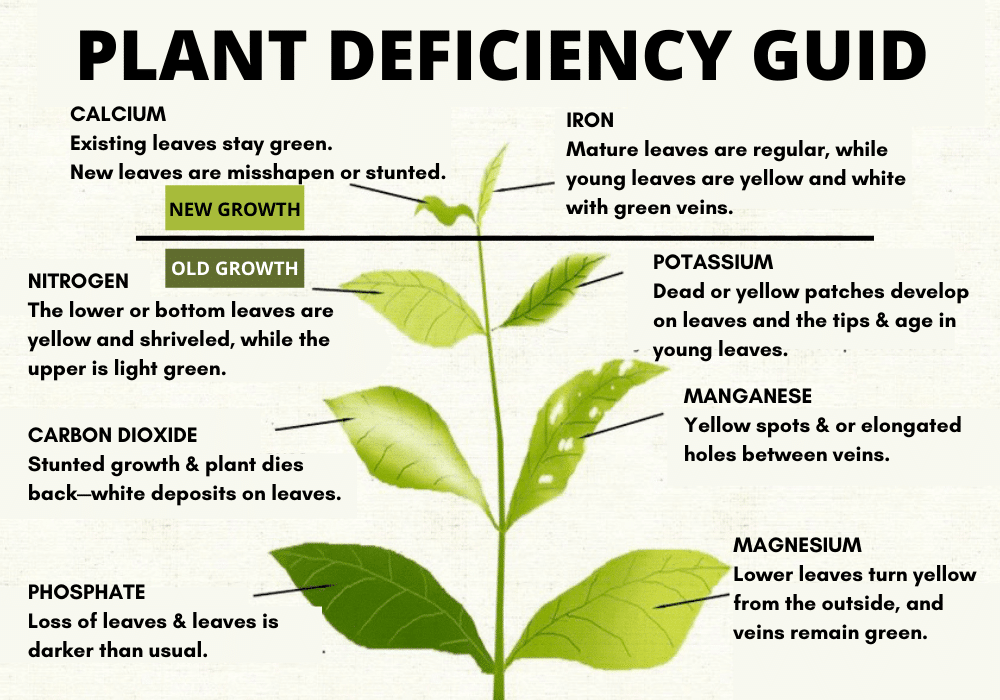
ใครก็ตามที่เคยประสบปัญหาใด ๆ จะบอกคุณ: การป้องกันปัญหานั้นง่ายกว่าการซ่อมแซมความเสียหายหลังจากข้อเท็จจริง บางครั้งนี้จะพูดง่ายกว่าทํา, อย่างไรก็ตาม, ดังนั้น, ดังนั้นคุณต้องเข้าใจสัญญาณและอาการของการขาดสารอาหารแต่ละ. มิฉะนั้นคุณอาจทําให้ปัญหาที่คุณพยายามแก้ไขรุนแรงขึ้นโดยไม่ได้ตั้งใจ
เราเน้นว่าคุณต้องเรียนรู้รายละเอียดเกี่ยวกับข้อบกพร่องเนื่องจากอาการของการขาดกัญชาต่างๆนั้นค่อนข้างคล้ายกัน สําหรับตาที่ไม่ได้รับการฝึกฝนแทบจะเป็นไปไม่ได้เลยที่จะแยกแยะความแตกต่างระหว่างการขาดแมงกานีสและการขาดธาตุสังกะสี (ทั้งสองอย่างทําให้ ใบจางลง) ถึงกระนั้นการรักษาสําหรับแต่ละคนก็แตกต่างกันมาก
เพื่อต่อสู้กับข้อบกพร่องในความหมายทั่วไป ผู้ปลูกมืออาชีพ หลายคนจะเลือกใช้สิ่งที่เราบางครั้งเรียกว่า "ปลาตัวเล็กในบ่อใหญ่" วิธีนี้เกี่ยวข้องกับการใช้กระถางดินที่อุดมด้วยสารอาหารขนาดใหญ่สําหรับพืชแต่ละชนิด พืชกัญชามีสารอาหารสํารองที่ใหญ่กว่ามากที่จะดึงออกมา
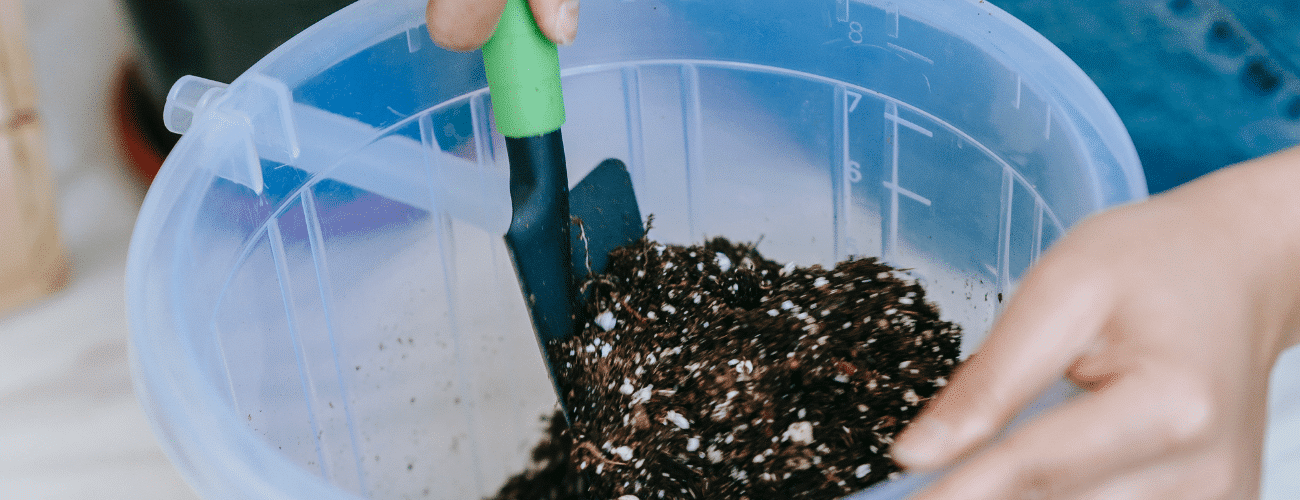
อย่างไรก็ตามขอเตือนว่าวิธีนี้มีข้อเสียเช่นกัน หัวหน้าในหมู่พวกเขาคือศักยภาพสําหรับพืชของคุณที่จะได้สัมผัสกับสารอาหาร ส่วนเกิน ใช่ - ไม่เพียง แต่คุณต้องระวังการขาดสารอาหาร แต่คุณยังต้องระวังสารอาหารส่วนเกินด้วย ตรวจสอบกราฟิกที่มีประโยชน์สําหรับข้อมูลเพิ่มเติมเกี่ยวกับการขาดสารอาหารหรือส่วนเกินต่างๆที่สามารถนําเสนอตัวเอง
นอกจากนี้ยังเป็นไปได้ที่พืชกัญชาของคุณจะประสบกับการขาดสารอาหารหลายอย่างพร้อมกัน หากคุณใช้ดินที่ดีและเตรียมอย่างมืออาชีพคุณจะสังเกตเห็นอาการของข้อบกพร่องต่าง ๆ อย่างไรก็ตาม อาจเป็นสัญญาณว่าค่า pH ในดินของคุณหมดสภาพแล้ว ทําให้เกิดการกักเก็บสารอาหารในรากพืชของคุณ
การขาดสารอาหาร – วิธีการวินิจฉัยและรักษาพวกเขา?
หากคุณสงสัยว่าคุณอาจมีปัญหาการขาดสารอาหารกับพืชกัญชาของคุณสิ่งที่ดีที่สุดที่ควรทําคือดําเนินการโดยเร็วที่สุด การจับมันแต่เนิ่นๆ สามารถสร้างโลกแห่งความแตกต่างได้ ถึงกระนั้นก่อนที่คุณจะเริ่มพยายามแก้ปัญหาคุณต้องสามารถระบุได้ว่าปัญหานั้นถูกต้องอย่างไร นาทีที่คุณสังเกตเห็นสัญญาณหรืออาการใด ๆ ที่มีบางอย่างไม่ถูกต้องกับพืชของคุณคุณควรสวมหมวก Sherlock Holmes ของคุณและไขปริศนาของสิ่งที่ผิดพลาด โปรดทราบว่ายิ่งคุณรอนานเท่าไหร่ปัญหาก็จะยิ่งส่งผลกระทบต่อผลผลิตและการเก็บเกี่ยวของคุณอย่างจริงจังมากขึ้นเท่านั้น ตั้งเป้าที่จะรักษาพืชของคุณให้มีสุขภาพที่ดีหรือใกล้จะสมบูรณ์แบบเสมอเพราะพืชที่ไม่แข็งแรงจะยอมจํานนต่อปัญหาได้เร็วกว่าพืชที่มีสุขภาพดี
นี่คือบางส่วนของการขาดสารอาหารที่พบมากที่สุด, อาการที่ระบุของพวกเขา, วิธีการรักษา, และวิธีการป้องกันพวกเขา.
การขาดไนโตรเจนในกัญชา
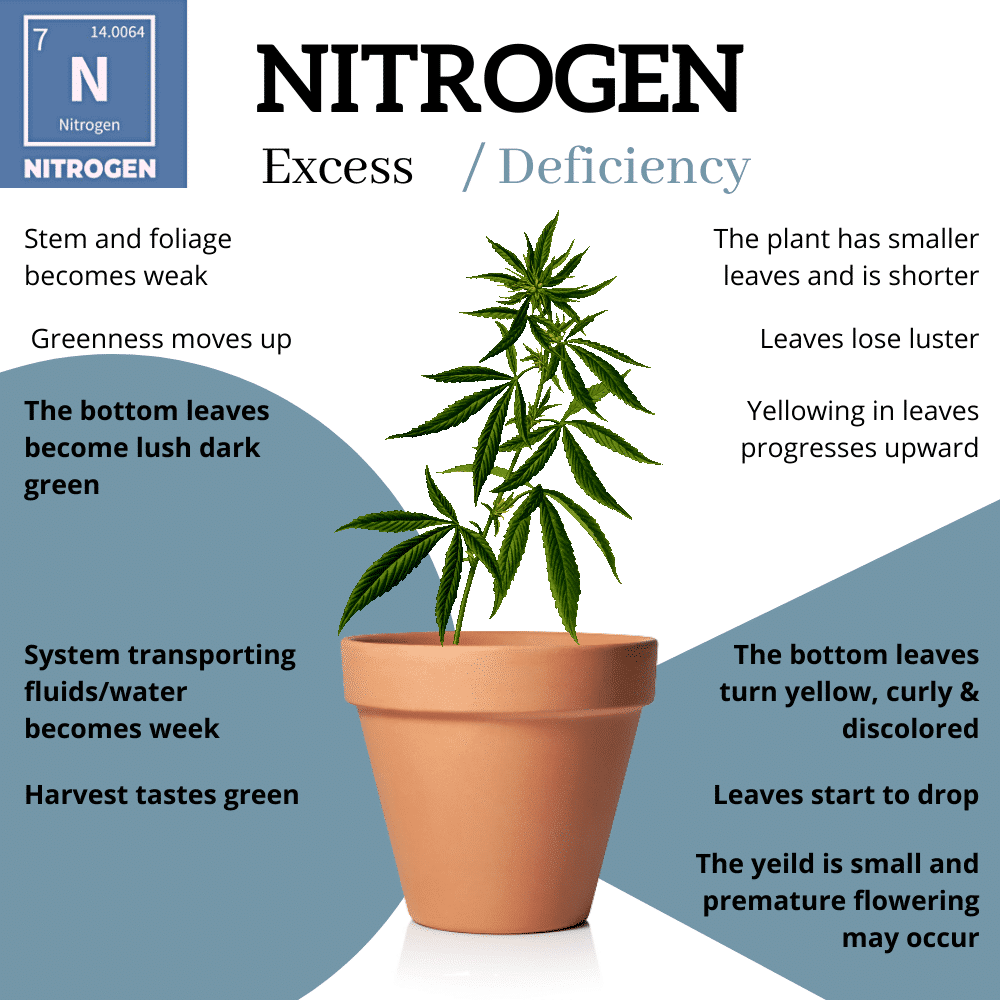
ไนโตรเจนเป็นธาตุอาหารหลักเคลื่อนที่ ไนโตรเจนมีความสําคัญต่อการสังเคราะห์ด้วยแสงและหากไม่มีไนโตรเจนพืชจะไม่สามารถเจริญเติบโตได้อย่างถูกต้อง
อาการ
การขาดไนโตรเจนสามารถระบุได้สองวิธีสําคัญ สัญญาณปากโป้งบางอย่างของการขาดไนโตรเจนในพืชกัญชาของคุณคือใบและใบอ่อนหรือสีเหลืองที่เริ่มขดตัวในตัวเองและในที่สุดก็ร่วงหล่น ตามปกติของการขาดสารอาหารรองอาการเหล่านี้จะเริ่มแสดงตัวเองในใบใกล้ด้านล่างของพืช นอกจากนี้ยังเป็นไปได้ที่ใบไม้จะเริ่มเป็นสีน้ําตาล อาการที่พบบ่อยอีกประการหนึ่งคือการเบ่งบานเร็วขึ้นโดยมีจุดตาน้อยลงและให้ผลผลิตลดลง
การรักษา
ขั้นแรก ให้ตรวจสอบเพื่อให้แน่ใจว่าระดับ pH ของคุณอยู่ในช่วงที่เหมาะสม หากเป็นเช่นนั้นคุณสามารถเพิ่มสารอาหารมาตรฐานลงในดินได้ หรือคุณสามารถใช้สเปรย์ป้อนอาหารทางใบเบา ๆ ที่เต็มไปด้วยสารละลายที่อุดมด้วยสารอาหาร สารอาหารจากปลา (และสเปรย์ทางใบจากปลา) มักมีไนโตรเจนสูง
การป้องกัน
ป้องกันการขาดไนโตรเจนโดยการตรวจสอบระดับ pH และปลูกกัญชาของคุณในส่วนผสมกระถางที่มีสารอาหารหนาแน่น
การขาดฟอสฟอรัสในกัญชา
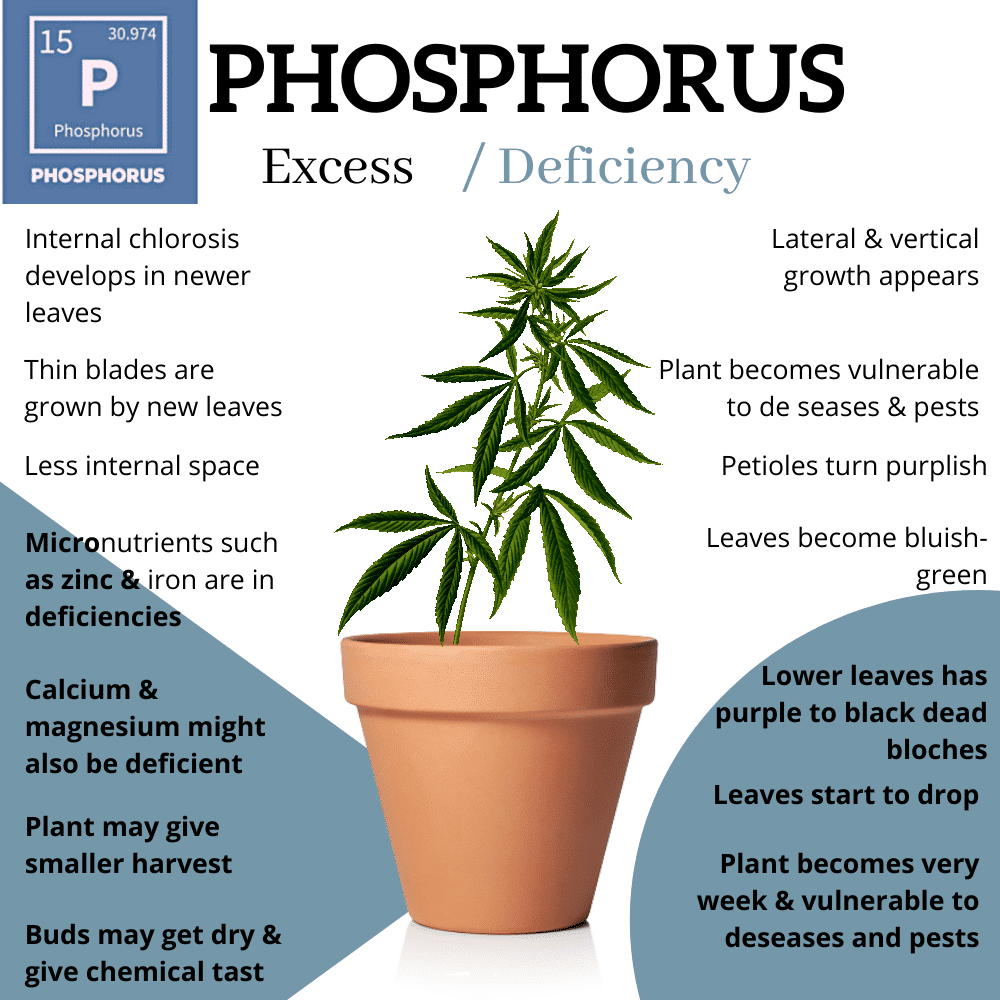
ฟอสฟอรัสเป็นธาตุอาหารหลักเคลื่อนที่อีกชนิดหนึ่งที่ช่วยให้พืชกัญชาของคุณเติบโตและรักษาสุขภาพให้แข็งแรง พืชกัญชาของคุณขึ้นอยู่กับฟอสฟอรัสเพื่อสร้างโปรตีนจากพืชและ DNA ของพืชและเช่นเดียวกับไนโตรเจนมันเป็นสิ่งจําเป็นต่อกระบวนการสังเคราะห์ด้วยแสง
อาการ
You can spot a Phosphorous deficiency by brown discoloration on the leaves or the appearance of red or purple dead spots on the stems of your leaves. Additionally (or) you may notice that the entire leaf seems to have taken on a darker hue, appearing dark blue or dark green. This nutrient deficiency can also cause leaves to curl and fall, and, like with Nitrogen, you will first notice these symptoms at the bottom of the plant.
การรักษา
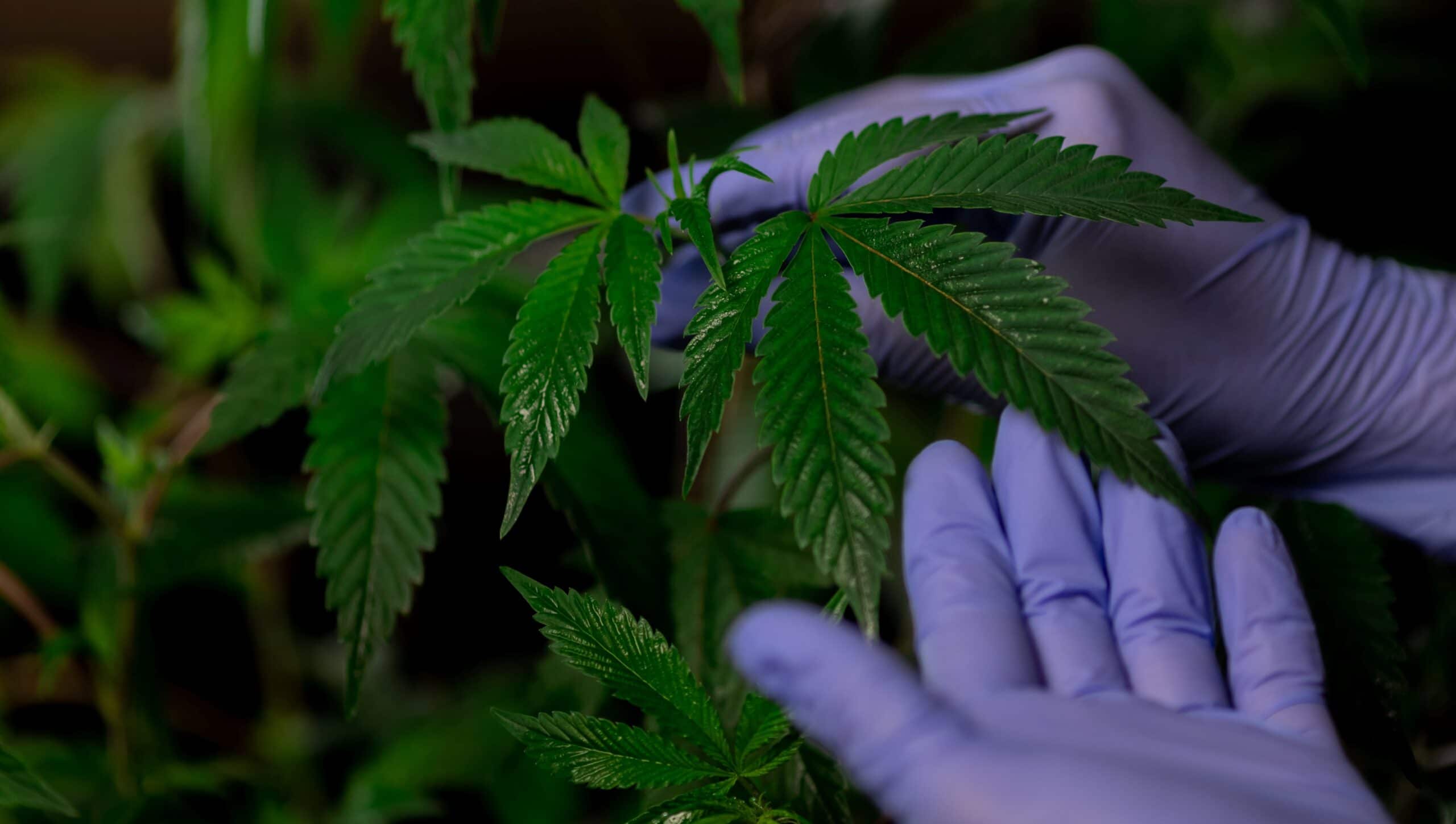
หลังจากตรวจสอบให้แน่ใจว่าค่า pH ของคุณเป็นปกติแล้ว ให้ลองเพิ่มอาหารหรือปุ๋ยที่อุดมไปด้วยฟอสฟอรัส สําหรับทางเลือกออร์แกนิก ให้ลองใช้ปลอกปลาหรือหนอนผีเสื้อแทน การรักษาอุณหภูมิให้อยู่ในช่วงที่เหมาะสมก็เป็นสิ่งจําเป็นเช่นกัน เนื่องจากอุณหภูมิที่เย็นกว่าอาจทําให้การดูดซึมฟอสฟอรัสทําได้ยาก นอกจากนี้อย่าให้น้ํามากเกินไปเพราะอาจทําให้สารอาหารเจือจางหรือกระจายสารอาหารก่อนที่จะถูกดูดซึม (และสามารถจมน้ําตายพืชของคุณได้!)
การป้องกัน
เริ่มต้นด้วยดินที่อุดมไปด้วยฟอสฟอรัสตั้งแต่เริ่มต้นและตรวจสอบให้แน่ใจว่าพวกเขาปลูกภาชนะที่มีการเติมอากาศอย่างดีและคุณใช้ปุ๋ยที่ดีเพื่อส่งเสริมสุขภาพของดินตั้งแต่เริ่มต้น
การขาดโพแทสเซียมในกัญชา
โพแทสเซียมเป็นธาตุอาหารหลักเคลื่อนที่อีกชนิดหนึ่งเป็นหนึ่งในสารอาหารที่จําเป็นต่อสุขภาพของพืชกัญชาของคุณ ในวงจรการเจริญเติบโตโพแทสเซียมมีความสําคัญต่อการพัฒนาและการขนส่งคาร์โบไฮเดรตและน้ําตาลอย่างง่ายและการบริโภคน้ําการแบ่งเซลล์และการเจริญเติบโตของราก
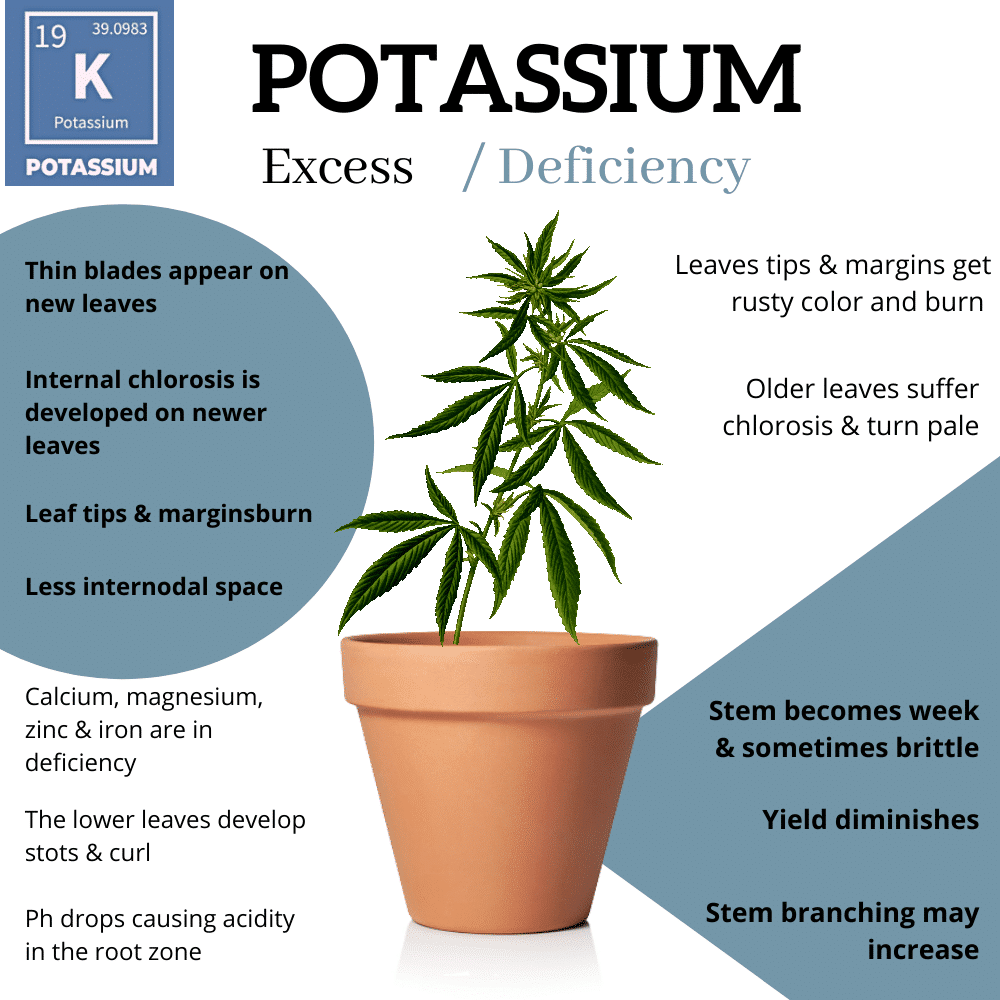 อาการ
อาการ
คุณสามารถสังเกตเห็นการขาดโพแทสเซียมโดยใบปลายสีน้ําตาลหรือสีเหลืองการม้วนงอของใบของพืชและการยืดโดยรวมของพืช (ซึ่งจะมากกว่าปกติ)
การรักษา
การเพิ่มมูลไก่ในระดับบนสุดของดินหรือสื่อทางเลือกของคุณสามารถช่วยได้หรือสําหรับทางเลือกอนินทรีย์คุณสามารถลองอาหารธาตุอาหารที่อุดมด้วยโพแทสเซียม
การป้องกัน
การให้อาหารพืชของคุณมากเกินไปสามารถสร้างเกลือสะสมและรบกวนการบริโภคโพแทสเซียม ดังนั้นคุณควรวัดปริมาณปุ๋ยที่คุณใช้อย่างระมัดระวังซึ่งไม่จําเป็นต้องดีกว่านี้ นอกจากนี้ให้แน่ใจว่าคุณไม่ได้รดน้ําต้นไม้ของคุณมากเกินไป
การขาดแมกนีเซียมในกัญชา
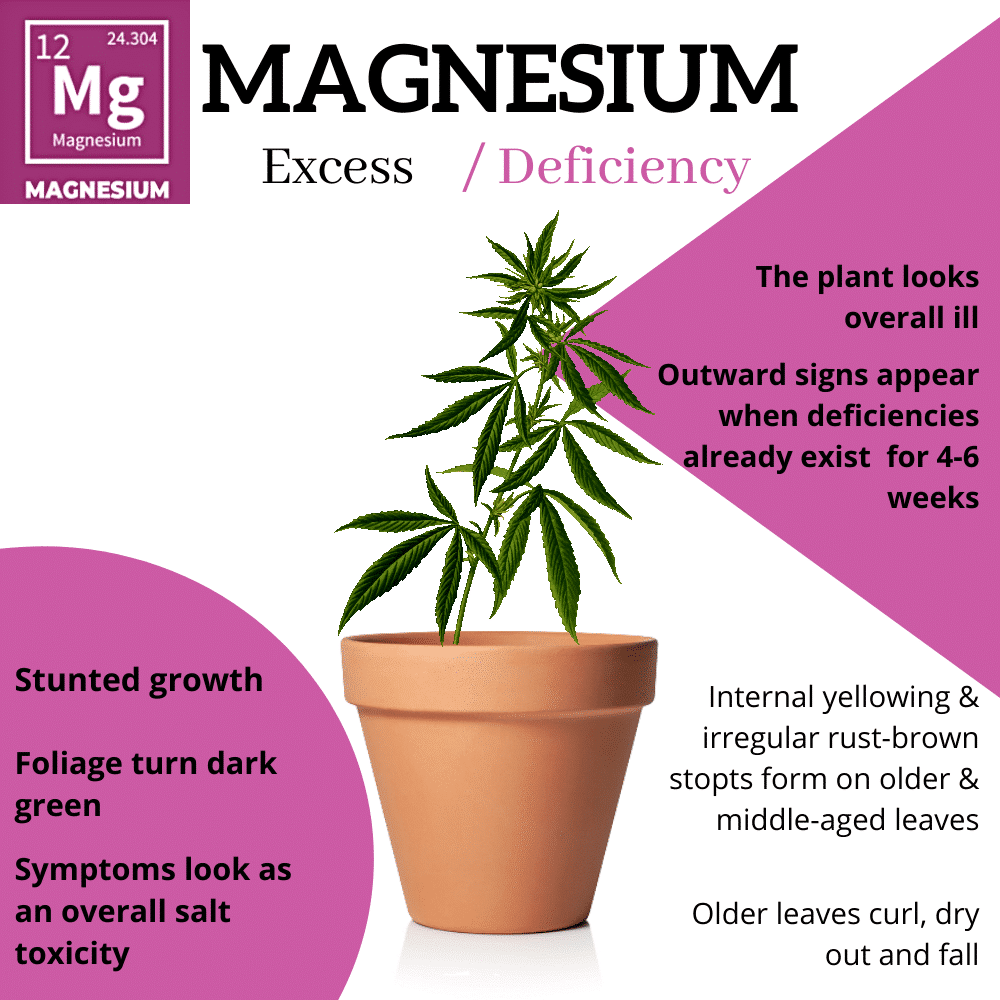
ซึ่งแตกต่างจากคนอื่น ๆ แมกนีเซียมเป็นสารอาหารรองที่ไม่สามารถเคลื่อนที่ได้ซึ่งหมายความว่าอาการขาดของมันจะปรากฏที่ด้านบนของพืชมากกว่าด้านล่าง สารอาหารนี้ช่วยให้การสังเคราะห์ด้วยแสงเกิดขึ้นและหากไม่มีการสังเคราะห์ด้วยแสงก็ไม่สามารถทําได้
อาการ
การขาดแมกนีเซียมจะเห็นได้ชัดเจนครั้งแรกในการเจริญเติบโตของใบใหม่ของพืช ตอนแรกใบไม้จะแสดงจุดสีเหลืองที่เปลี่ยนเป็นสีน้ําตาลในที่สุดและนําไปสู่การตายของใบที่ได้รับผลกระทบ บนใบที่มีอายุมากกว่าพื้นที่ระหว่างเส้นเลือดจะเปลี่ยนเป็นสีเหลืองหรืออาจแสดงจุดสีสนิมตลอด
การรักษา
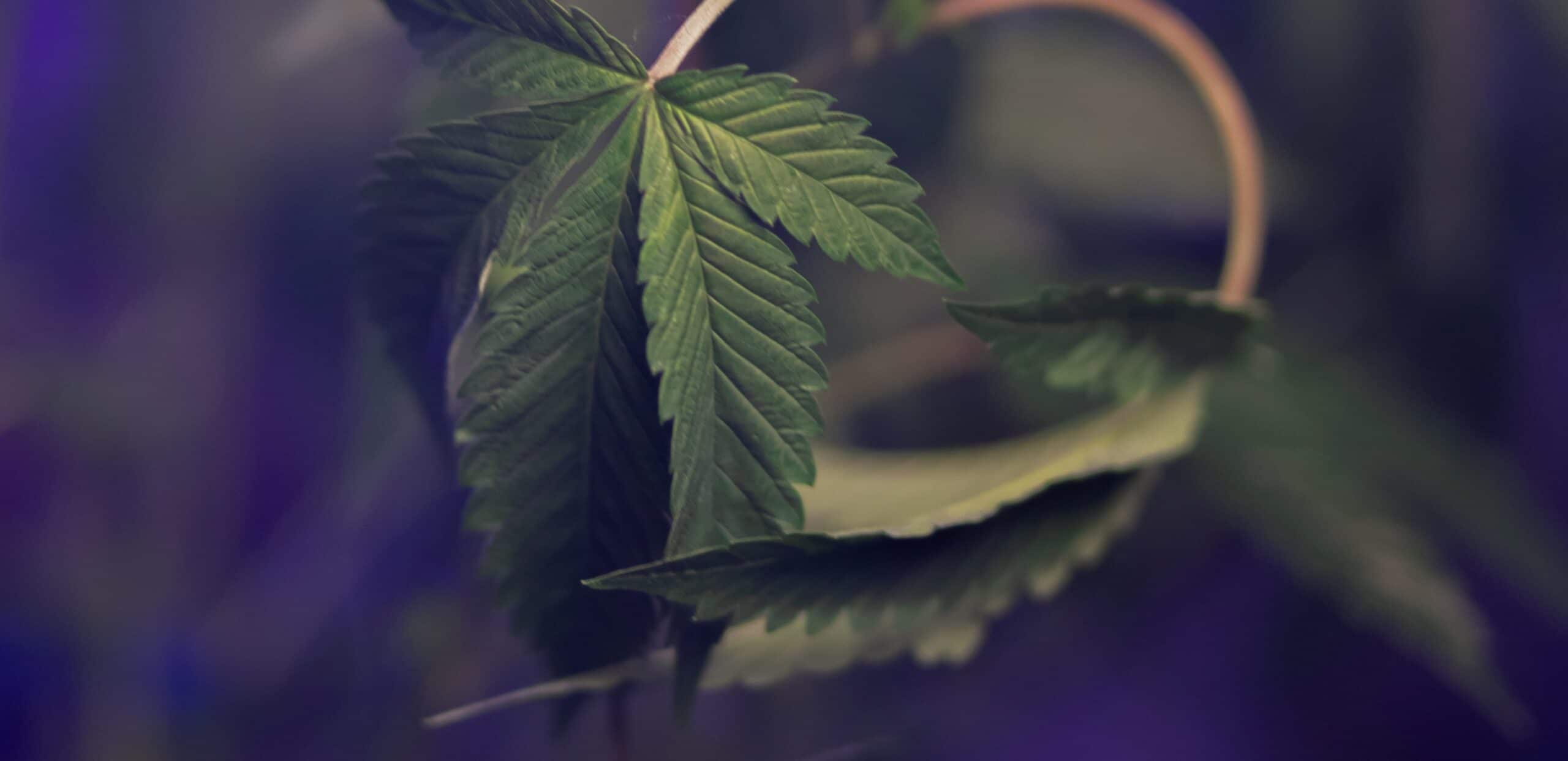
หลังจากตรวจสอบว่าระดับ pH ของคุณไม่เป็นไรคุณสามารถเพิ่มเกลือ Epsom หนึ่งช้อนชาลงในน้ําสี่ลิตรแล้วนําไปใช้กับพืชของคุณจนกว่าอาการจะหายเป็นปกติ
การป้องกัน
เพื่อป้องกันการขาดแมกนีเซียมให้ลองรักษาดินหรือสื่อการเจริญเติบโตของคุณด้วยหินปูนโดโลมิติก คุณยังสามารถใช้ปุ๋ยหมักที่อุดมด้วยปุ๋ยคอก และเช่นเคย อย่าลืมตรวจสอบระดับ pH ของคุณด้วย
การขาดแคลเซียมในกัญชา
แคลเซียมเป็นสารอาหารรองที่ไม่สามารถเคลื่อนที่ได้อีกชนิดหนึ่งที่ช่วยให้พืชสร้างโครงสร้างและเสริมความแข็งแกร่งให้กับเซลล์ของมัน
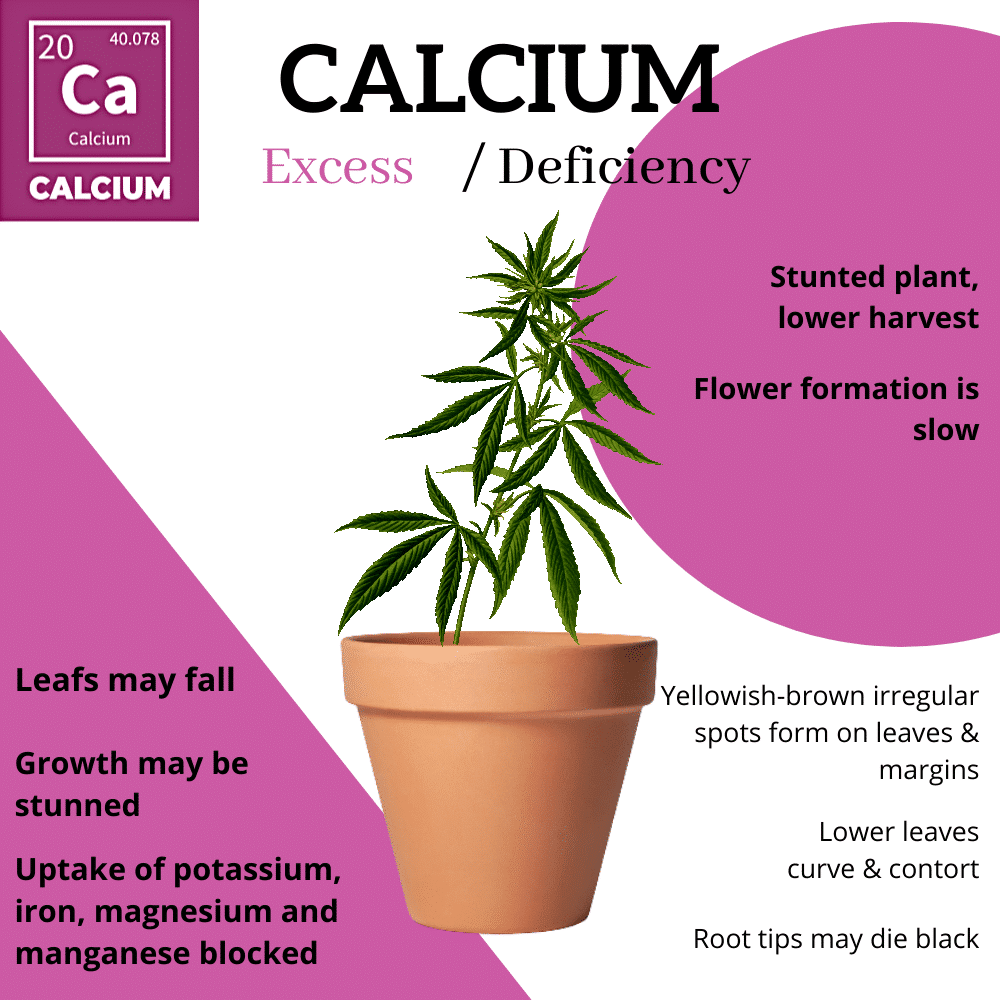
อาการ
สถานที่แรกที่คุณจะสังเกตเห็นการขาดแคลเซียมอยู่ในใบใหม่ของพืชกัญชาของคุณ มองหาจุดสีน้ําตาลเล็ก ๆ ที่มีลักษณะแคระแกรนหรือการเจริญเติบโตที่ผิดปกติ (ส่งผลให้ใบผิดรูป) ใบม้วนงอที่ปลายหรือย่นของใบ
การรักษา
ลองใช้อาหารเสริมที่อุดมไปด้วยแคลเซียมเพื่อแก้ปัญหาอย่างรวดเร็ว คุณยังสามารถลองแก้ไขค่า pH ของดินของคุณเพื่อให้อยู่ใกล้กับ 6.2 มากที่สุด นอกจากนี้ลองเติมมะนาวไฮเดรตหนึ่งช้อนชาลงในน้ําสี่ลิตรและบําบัดพืชกัญชาของคุณด้วยวิธีแก้ปัญหาจนกว่าปัญหาจะแก้ไขได้

การป้องกัน
ปัญหาอีกประการหนึ่งสามารถป้องกันได้โดยการเสริมดินของคุณด้วยปูนขาวโดโลมิติกหรือมะนาวสวน หากใช้ปุ๋ยหมักอินทรีย์ให้ลองเพิ่มเปลือกไข่ลงในส่วนผสมปุ๋ยหมัก
การขาดโบรอนในกัญชา
โบรอนเป็นสารอาหารรองที่ไม่สามารถเคลื่อนที่ได้ซึ่งทํางานร่วมกับแคลเซียมเพื่อให้ผนังเซลล์มีสุขภาพดีและช่วยในการแบ่งเซลล์ให้แข็งแรง เนื่องจากสารอาหารนี้เป็นสารอาหารรอง, พืชกัญชาไม่ต้องการมากของมัน, และเป็นผลให้, การขาดโบรอนไม่พบมากที่สุด.
อาการ
การขาดโบรอนในพืชกัญชาของคุณจะนําเสนอเป็นพืชที่เหี่ยวแห้งที่มีการเจริญเติบโตของพืชที่ไม่ดี การเจริญเติบโตใหม่มีแนวโน้มที่จะปรากฏบิดเบี้ยวหรือบิดเบี้ยวและใบจะใช้เวลาในการเปลี่ยนสีสีน้ําตาลหรือสีเหลือง
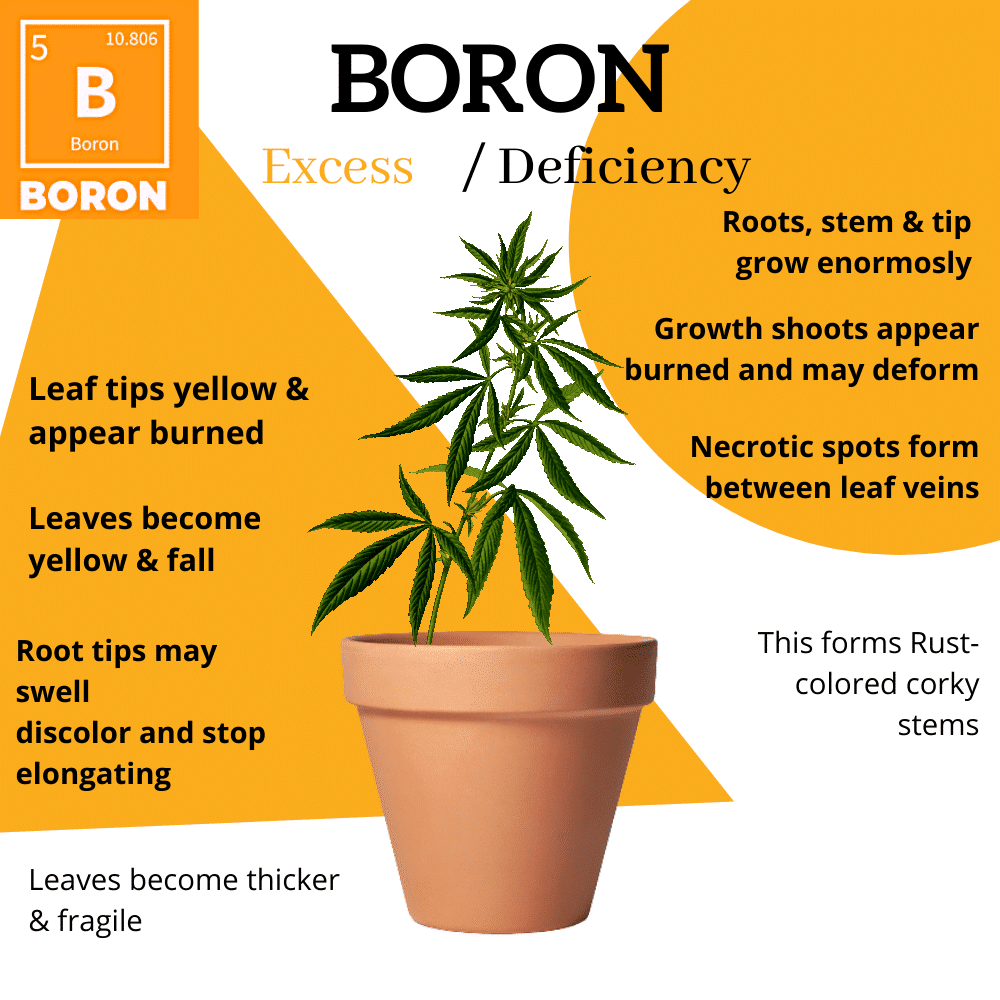
การรักษา
หากระดับ pH ของคุณอยู่ในช่วงที่เหมาะสมคุณสามารถรักษาการขาดโบรอนได้โดยการเติมกรดบอริกหนึ่งช้อนชาลงในน้ําสี่ลิตรแล้วนําไปใช้กับพืชที่ได้รับผลกระทบของคุณ
การป้องกัน
ป้องกันการขาดโบรอนโดยการทําให้พืชชุ่มชื้นและหลีกเลี่ยงการให้อาหารมากไปเนื่องจากอาจทําให้เกิดการล็อคสารอาหาร ระดับความชื้นที่คุณรักษาพืชกัญชาของคุณควรอยู่เหนือ 25% และดินที่คุณใช้จะต้องมีการเติมอากาศอย่างดีและระบายน้ําได้ดี
การขาดทองแดงในกัญชา

ทองแดงจัดเป็นสารอาหารรองกึ่งเคลื่อนที่ที่ช่วยให้พืชดูดซับและใช้ไนโตรเจน ทองแดงยังรับผิดชอบในการช่วยเหลือความสามารถของพืชในการเผาผลาญคาร์โบไฮเดรต. การขาดนี้เป็นเรื่องผิดปกติมากเนื่องจากทองแดงเป็นสารอาหารรองและจําเป็นในปริมาณเล็กน้อยเท่านั้น
อาการ
หากพืชกัญชาของคุณกําลังทุกข์ทรมานจากการขาดทองแดงมันจะค่อยๆเริ่มเหี่ยวเฉาและอาจมาพร้อมกับการเติบโตใหม่ที่บิดเบี้ยว ใบอาจพัฒนา undertones สีน้ําเงินเข้มหรือสีม่วงและเคล็ดลับที่ปรากฏสีเหลืองอ่อนหรือสีขาว ใบที่ขาดทองแดงอาจรู้สึกแข็งทื่อเมื่อสัมผัสและคุณอาจสังเกตเห็นว่าตาไม่สุกหรือเติบโตช้าอย่างไม่น่าเชื่อ
การรักษา
สาเหตุที่พบบ่อยที่สุดของการขาดทองแดงคือค่า pH ของดินที่ไม่สมดุล คุณสามารถปรับค่า pH ให้อยู่ในช่วงที่ถูกต้องได้หากคุณสังเกตเห็นข้อบกพร่องนี้ นอกจากนี้พยายามหลีกเลี่ยงการรดน้ํามากเกินไป
การป้องกัน
ตรวจสอบให้แน่ใจว่าคุณไม่ได้รดน้ําต้นไม้มากเกินไปและตรวจสอบระดับ pH เพื่อให้แน่ใจว่าโรงงานจะอยู่ในช่วงที่เหมาะสม
การขาดธาตุเหล็กในกัญชา
เหล็กซึ่งเป็นสารอาหารรองที่เคลื่อนที่ไม่ได้เป็นสิ่งจําเป็นสําหรับกระบวนการขึ้นรูปพลังงานของพืช นอกจากนี้ธาตุเหล็กยังมีความสําคัญต่อการพัฒนาคลอโรฟิลล์เอนไซม์หลายชนิดและเม็ดสีอินทิกรัล
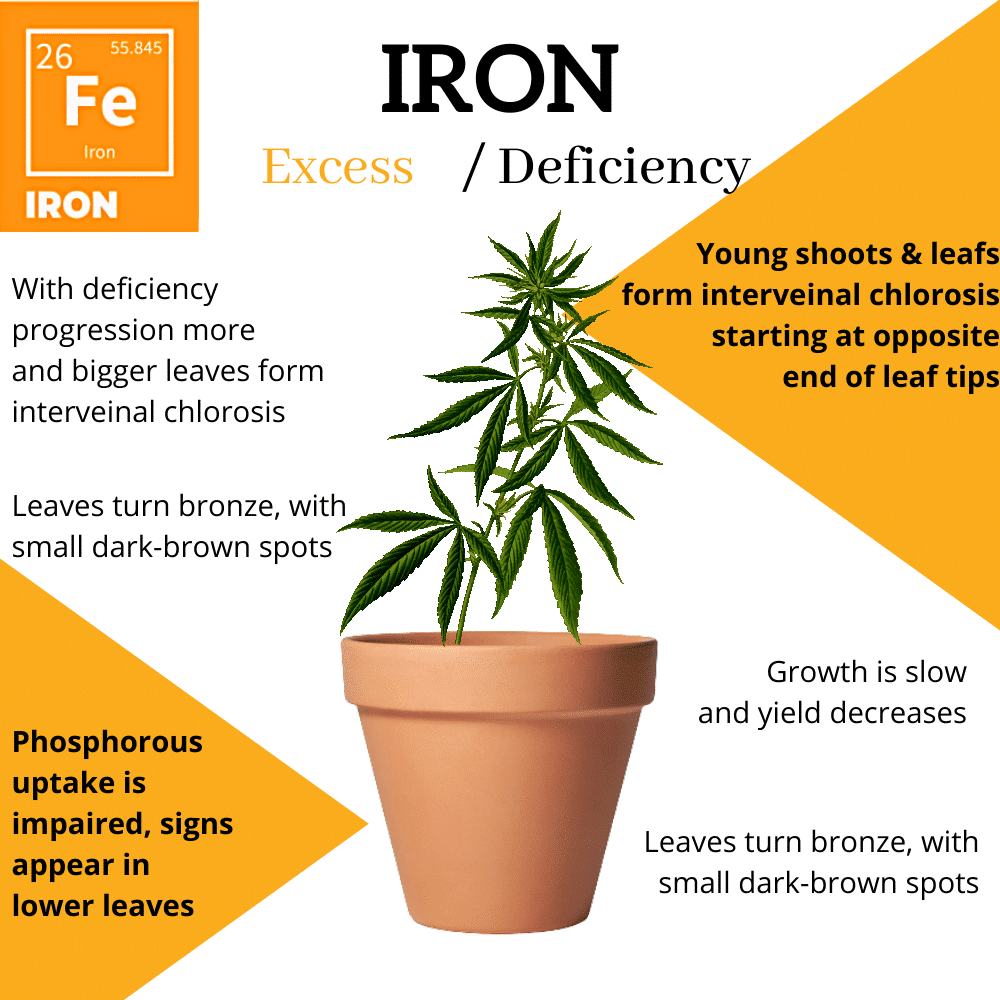
อาการ
ในฐานะที่เป็นสารอาหารที่เคลื่อนที่ไม่ได้อาการของการขาดธาตุเหล็กจะปรากฏที่ด้านบนของพืชในการเจริญเติบโตของใบใหม่ คุณอาจสังเกตเห็นการเปลี่ยนสีระหว่างเส้นเลือดของใบเช่นเดียวกับใบที่ด้านบนของพืชเปลี่ยนเป็นสีเหลืองสดใส
การรักษา
หากค่า pH ในดินของคุณอยู่ในระดับที่เหมาะสมคุณสามารถลองล้างสื่อการเจริญเติบโตแล้วเพิ่มอาหารเสริมธาตุเหล็กพิเศษหลังจากเสร็จสิ้น คุณยังสามารถใช้ปุ๋ยที่อุดมด้วยไนโตรเจนจํานวนเล็กน้อยซึ่งจะช่วยลดค่า pH ของดินและทําให้พืชสามารถเข้าถึงเหล็กได้มากขึ้น
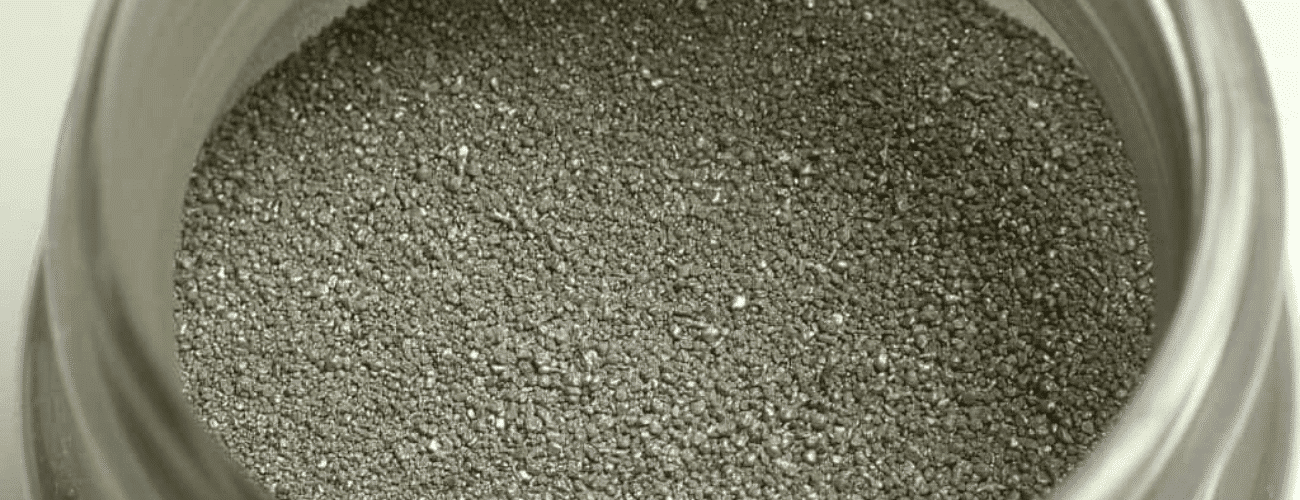
การป้องกัน
ป้องกันการขาดธาตุเหล็กโดยการเพิ่ม mycorrhizae ลงในดินตรวจสอบระดับ pH ของคุณและเพิ่มมูลไก่สาหร่ายทะเลและเศษซากครัวลงในปุ๋ยหมักของคุณ
การขาดแมงกานีสในกัญชา
แมงกานีสเป็นสารอาหารรองที่ไม่สามารถเคลื่อนที่ได้อีกชนิดหนึ่งที่เป็นพื้นฐานของสรีรวิทยาของพืชกัญชา สารอาหารรองนี้มีบทบาทสําคัญในการหายใจการดูดซึมไนโตรเจนการสังเคราะห์ด้วยแสงและการยืดตัวของเซลล์ราก ยิ่งไปกว่านั้นมันยังช่วยปกป้องรากของพืชจากจุลินทรีย์ที่เป็นอันตรายอีกด้วย!
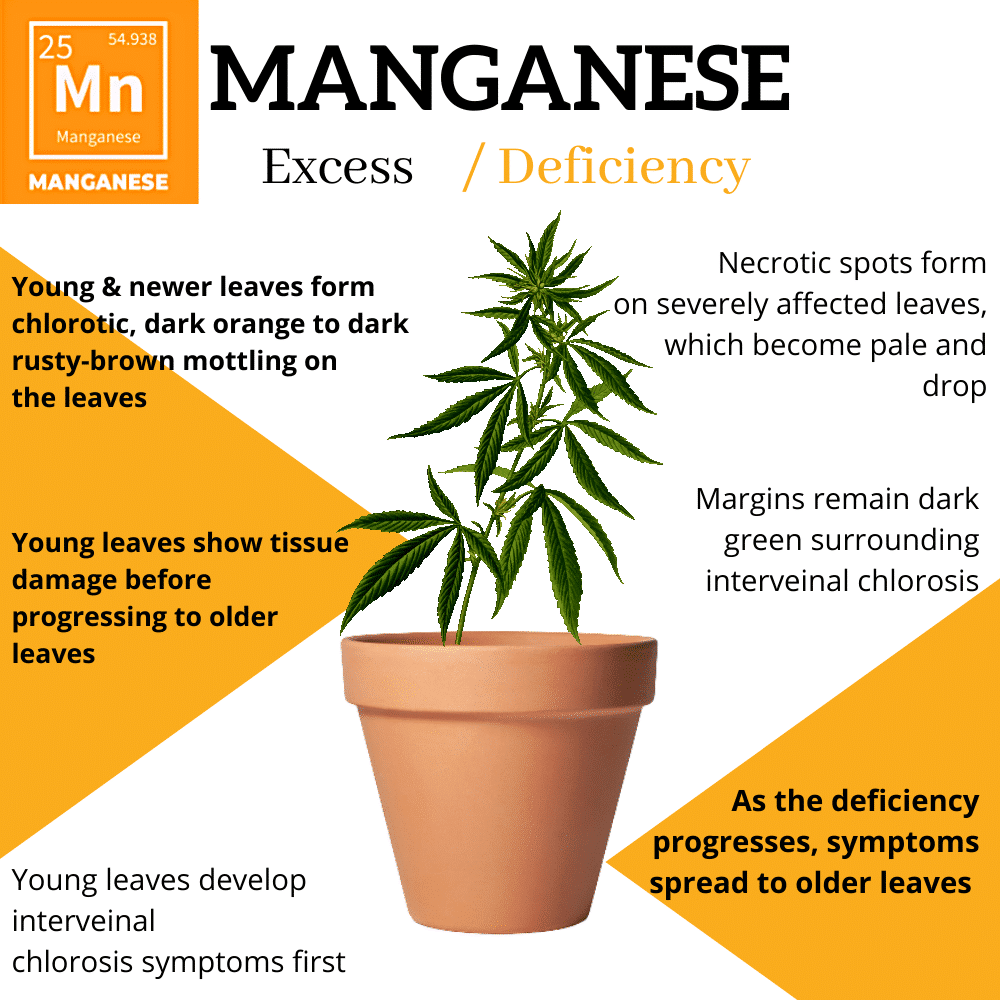
อาการ
การขาดแมงกานีสถูกพบโดยใบซีดหรือการเปลี่ยนสีที่จะส่งผลต่อการเจริญเติบโตใหม่ก่อน คุณอาจสังเกตเห็นจุดสีน้ําตาลบนใบหากปัญหายังคงมีอยู่เป็นระยะเวลานาน
การรักษา
ในการรักษาภาวะขาดแมงกานีสให้ล้างภาชนะของคุณและตัดการเจริญเติบโตที่ได้รับผลกระทบออกไป
การป้องกัน
ป้องกันการขาดนี้โดยการตรวจสอบค่า pH ของดินของคุณเนื่องจากความไม่สมดุลของค่า pH มักจะถูกตําหนิสําหรับการขาดแมงกานีส
การขาดกํามะถันในกัญชา
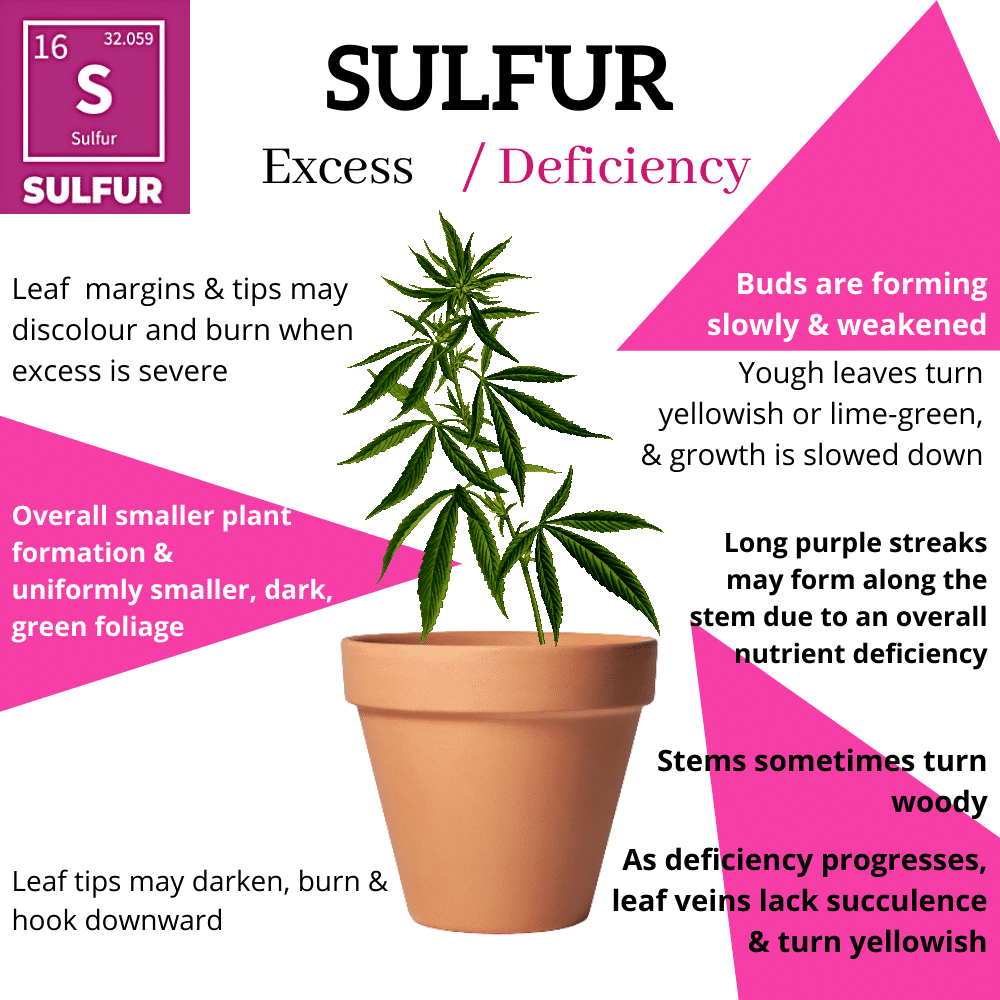
เช่นเดียวกับแมงกานีสซัลเฟอร์เป็นสารอาหารรองที่ไม่สามารถเคลื่อนที่ได้ซึ่งช่วยให้พืชกัญชาสร้างโปรตีนและเอนไซม์ที่สําคัญ
อาการ
การขาดซัลเฟอร์นั้นค่อนข้างผิดปกติ แต่คุณจะสังเกตเห็นว่าใบอ่อนของคุณเปลี่ยนเป็นสีเขียวมะนาวก่อนแล้วจึงเปลี่ยนเป็นสีเหลืองอ่อนหากคุณมี นอกจากนี้ยังเป็นไปได้ที่จะเห็นการเจริญเติบโตแคระแกรนของใบใหม่หรือใบที่ แห้งและ เปราะเมื่อสัมผัส
การรักษา
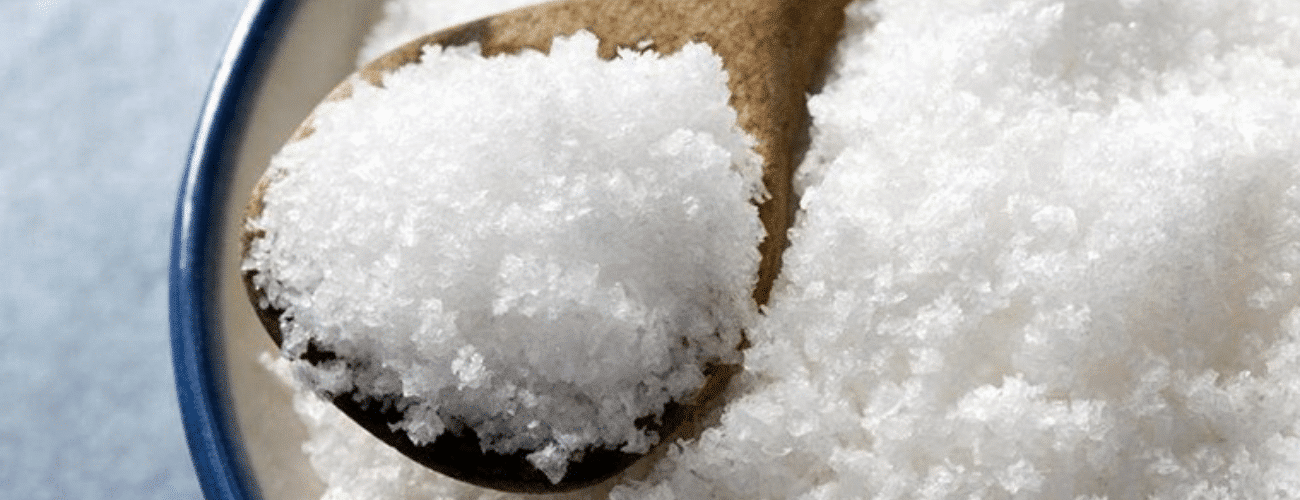
รักษาข้อบกพร่องนี้โดยการเพิ่มเกลือ Epsom 1 ถึง 2 ช้อนชาลงในน้ําสี่ลิตรและรักษาพืชด้วยสารละลายจนกว่าอาการจะหายเอง
การป้องกัน
คุณสามารถป้องกันการขาดกํามะถันได้โดยการใส่ปุ๋ยคอกลงในกองปุ๋ยหมักของคุณหรือเพิ่ม mycorrhizae ลงในหม้อของคุณ
การขาดธาตุสังกะสีในกัญชา
สารอาหารรองที่ไม่สามารถเคลื่อนที่ได้ตัวสุดท้ายคือสังกะสีซึ่งจําเป็นต่อการรักษาพืชให้แข็งแรงและต่อสู้กับความเจ็บป่วย (เช่นเดียวกับในมนุษย์!) นอกจากนี้สังกะสียังช่วยควบคุมการทํางานของเอนไซม์ทั่วทั้งโรงงานและช่วยในการรักษาเสถียรภาพของ DNA และ RNA
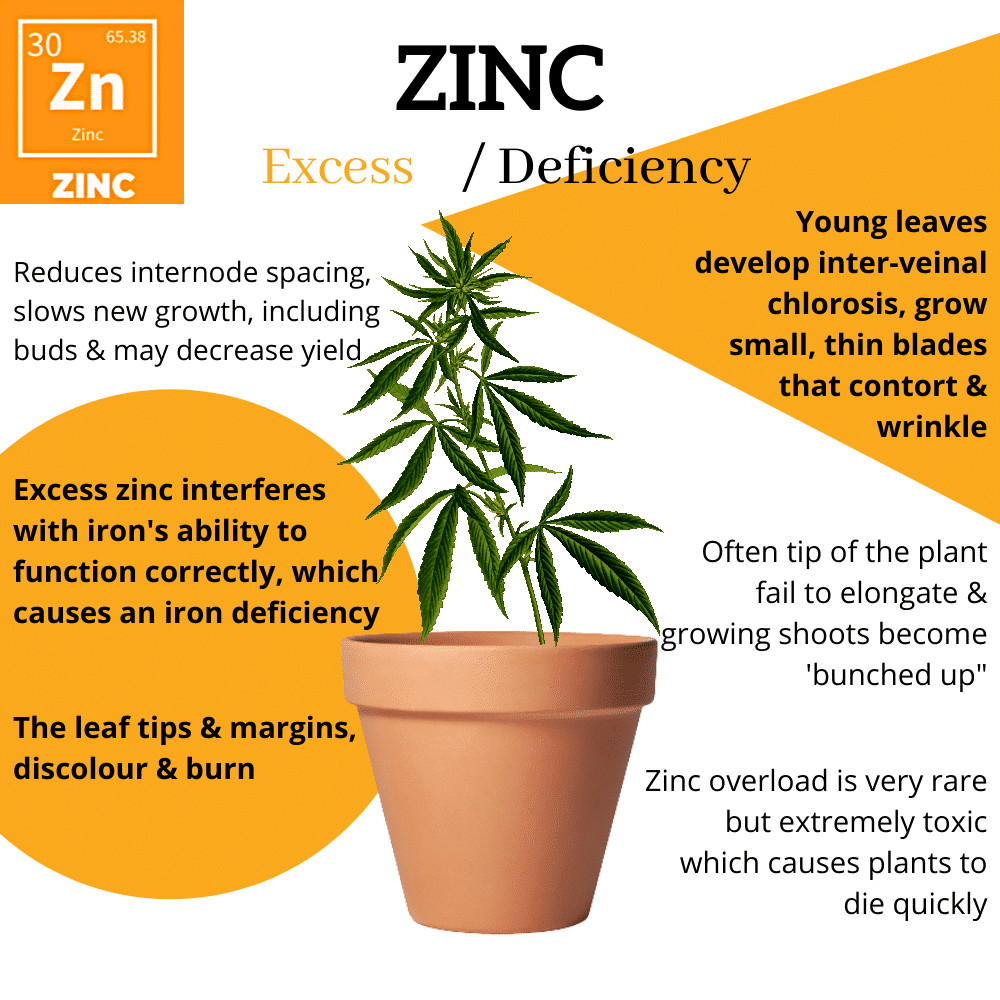
อาการ
การขาดนี้มักนําเสนอเป็นการเปลี่ยนสีฟ้าผ่าระหว่างเส้นเลือดของใบทําให้เกิดผลเป็นลาย คุณอาจสังเกตเห็นแผลไหม้สีน้ําตาลที่ปลายใบ อย่างไรก็ตามควรสังเกตว่าการขาดนี้ไม่ธรรมดามาก
การรักษา
ตรวจสอบให้แน่ใจว่าค่า pH ของดินอยู่ในช่วงที่เหมาะสม จากนั้นใช้สเปรย์ทางใบของปลาหรือสาหร่ายทะเลเพื่อช่วยยกระดับสังกะสีอย่างรวดเร็ว
การป้องกัน
คุณสามารถเพิ่มฟักทองหรือเศษสควอชอื่น ๆ ลงในปุ๋ยหมักของคุณเพื่อเพิ่มระดับสังกะสีและตรวจสอบและรักษาระดับ pH ที่เหมาะสมของดินของคุณ
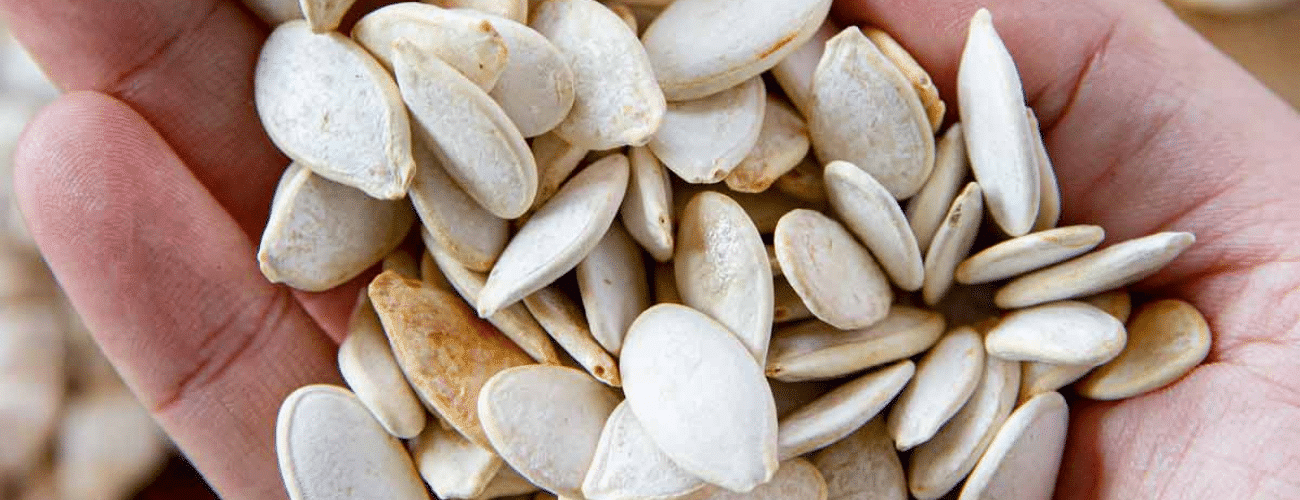
วิธีการรักษาพืชกัญชาของคุณให้แข็งแรง?
การรักษาพืชของคุณให้แข็งแรงเป็นสิ่งสําคัญสําหรับการเพิ่มผลผลิตสูงสุดและทําให้แน่ใจว่าพวกมันเกาะติดเป็นเวลานาน พืชมีชุดของสารอาหารที่กําหนดซึ่งพวกเขาต้องการในการเจริญเติบโตและทํางานอย่างถูกต้อง, และหากไม่มีสารอาหารเหล่านี้, คุณจะเริ่มสังเกตเห็นผลข้างเคียงได้อย่างรวดเร็ว. คุณสามารถคิดว่าสารอาหารเหล่านี้เป็นส่วนต่าง ๆ ของเครื่องยนต์รถยนต์ - รถอาจยังคงทํางานโดยไม่มีชิ้นส่วนใดส่วนหนึ่ง แต่คุณอาจไปได้ไม่ไกลเลย
สารอาหารเหล่านี้มีความสําคัญต่อการช่วยให้พืชกัญชาของคุณทําหน้าที่ทางสรีรวิทยาที่จําเป็นในการผลิตผลผลิตที่คุณต้องการ แต่น่าเสียดายที่การขาดในแม้แต่หนึ่งในสารอาหารเหล่านี้อย่างมีนัยสําคัญสามารถส่งผลกระทบอย่างมีนัยสําคัญผลผลิตและการผลิตของคุณ
หากคุณสังเกตเห็นว่าพืชของคุณเริ่มดูแย่ลงเล็กน้อยสําหรับการสึกหรออย่าตกใจ สิ่งเหล่านี้เกิดขึ้นและตอนนี้คุณรู้ทุกอย่างเกี่ยวกับการขาดสารอาหารแล้วคุณจะสามารถก้าวเข้ามาและประหยัดวันได้ โปรดทราบว่าในหลายกรณีผู้กระทําผิดที่รับผิดชอบจะเป็นค่า pH ของดินที่ไม่สมดุล แม้ว่าจะดูรุนแรง แต่เมื่อค่า pH ของดินไม่อยู่ในช่วงที่ถูกต้องรากจะไม่สามารถดูดซับสารอาหารที่ต้องการได้ แม้ว่าดินจะอุดมไปด้วยสารอาหารที่สําคัญทุกอย่าง แต่ก็ไม่มีอะไรเปลี่ยนแปลงจนกว่าจะมีการปรับระดับ pH
เมื่อพยายามวินิจฉัยการขาดสารอาหารในพืชกัญชาของคุณให้ดูอาการทั้งหมดอย่างใกล้ชิดเพื่อระบุอาการที่ถูกต้อง เนื่องจากสารอาหารส่วนเกินเป็นไปได้คุณไม่ต้องการให้สารอาหารแก่พืชของคุณมากเกินไปแทนที่จะแก้ปัญหาการขาดสารอาหารอื่น
มันจะช่วยได้ถ้าคุณยังเก็บไว้ในใจว่าการขาดสารอาหารอาจไม่ใช่ปัญหาเลยในบางกรณี. พืชกัญชามีความไวต่อหลายสิ่งหลายอย่างและการขาดสารอาหารมีเพียงไม่กี่อย่าง ตรวจสอบให้แน่ใจว่าคุณให้ความสนใจอย่างใกล้ชิดกับปริมาณที่คุณรดน้ําต้นไม้ของคุณเพราะการรดน้ํามากเกินไปอาจทําให้เกิดปัญหามากมาย (รวมถึงการป้องกันไม่ให้พืชของคุณดูดซับสารอาหารที่สําคัญ) คุณจะต้องตรวจสอบให้แน่ใจว่าอุณหภูมิของพื้นที่ที่คุณปลูกกัญชาของคุณอยู่ในช่วงที่เหมาะสมและความชื้นก็เช่นเดียวกัน มันจะช่วยได้ถ้าคุณตั้งเป้าที่จะรักษาความชื้นของพื้นที่ไว้ประมาณ 40-50% และอุณหภูมิระหว่าง 68 ถึง 77 องศาฟาเรนไฮต์
การปลูกกัญชามักจะค่อนข้างง่าย แต่ในตอนแรกอาจใช้เวลาสักครู่ในการพัฒนาระบบหรือวิธีการที่เหมาะกับคุณ ผู้ปลูกพืชใหม่จํานวนมาก (ไม่ใช่แค่ผู้ปลูกกัญชา) มักจะไม่ค่อยสนใจการให้อาหารหรือรดน้ําต้นไม้มากเกินไปซึ่งอาจทําให้เกิดปัญหามากมายโดยไม่ได้ตั้งใจ โปรดจําไว้ว่าพืชเหล่านี้วิวัฒนาการเพื่อเจริญเติบโตในสภาพที่เฉพาะเจาะจงและตราบใดที่คุณสามารถเลียนแบบเงื่อนไขเหล่านั้นได้พวกเขาควรทําได้ดี
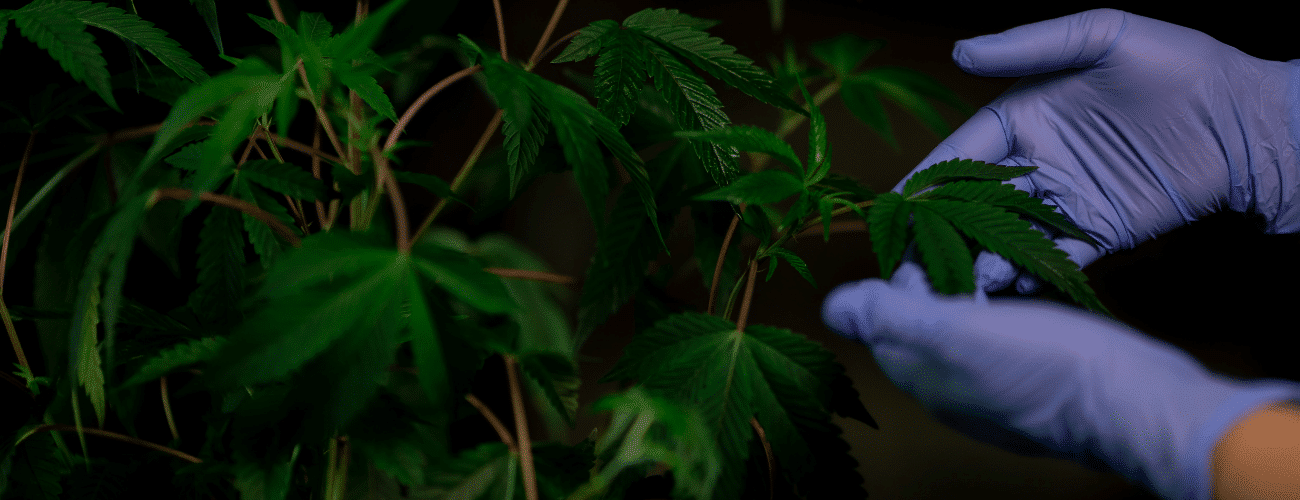
เมื่อพูดถึงการเลือกดินหรือสื่อการเจริญเติบโตมีผู้ผลิตจํานวนมากที่เชี่ยวชาญในการสร้างผลิตภัณฑ์เหล่านั้นสําหรับพืชกัญชาโดยเฉพาะ ขึ้นอยู่กับสิ่งที่คุณต้องการคุณจะสามารถหาวิธีการอินทรีย์หรือสังเคราะห์ในการส่งสารอาหารที่สําคัญให้กับพืชของคุณและไม่ถูกหรือผิด อย่างไรก็ตามเราขอแนะนําให้คุณสอดคล้องกับสิ่งที่คุณเลือกเนื่องจากสามารถช่วยให้พืชของคุณเป็นไปตามแผนได้
คู่มือการขาดกัญชา (FAQ):
การขาดสารอาหารมีลักษณะอย่างไรในกัญชา?
ตรวจสอบใบเพื่อหาสัญญาณใด ๆ ของโรคเช่นแพทช์ที่ตายแล้ว, ย่น, จุดสีน้ําตาลเล็ก ๆ น้อย ๆ , การพัฒนาที่ชะลอตัว, ใบเล็กหรือบิด, เคล็ดลับขดและสีเขียวเข้มรอบ ๆ พื้นที่ได้รับผลกระทบ เป็นเรื่องปกติที่พืชจะขาดแคลเซียม แมกนีเซียม และธาตุเหล็กทั้งหมดในเวลาเดียวกัน
การขาดไนโตรเจนมีลักษณะอย่างไรในพืชกัญชา?
ไนโตรเจนไม่เพียง แต่เป็นส่วนประกอบสําคัญของโปรตีนที่พบในพืช แต่ยังมีความสําคัญต่อกระบวนการผลิตการสังเคราะห์ด้วยแสงที่เหมาะสมโดยเฉพาะอย่างยิ่งในช่วงการเจริญเติบโตของพืช การขาดไนโตรเจนอาจทําให้ใบบนพืชกลายเป็นสีเหลืองม้วนงอและร่วงหล่นทําให้พืชมีลักษณะที่น่าเบื่อหน่าย
การล็อคสารอาหารมีลักษณะอย่างไร?
มันปรากฏขึ้นอย่างไรเมื่อสารอาหารถูกบล็อก? ตามที่ระบุไว้ก่อนหน้านี้พืชกัญชาจะเริ่มแสดงอาการของการขาดสารอาหาร จะมีสีซีดทั่วไปและมีลักษณะแคระแกรนกับพืชเอง พืชที่มีใบอ่อนอาจเห็นการลดลงของการพัฒนาราก
กัญชาใช้เวลานานแค่ไหนในการฟื้นตัวจากการขาดสารอาหาร?
ประมาณหนึ่งสัปดาห์
พืชที่หิวโหยไนโตรเจนจะรับสารอาหารอย่างรวดเร็วเมื่อมันพร้อมใช้งานแล้ว จะมีการปรับปรุงสีของพืชเป็นสีเขียวสดใสมากขึ้น ใบที่เสียหายไม่สามารถงอกกลับคืนมาได้ โดยปกติ, ชีวิตของพืชสามารถเด้งกลับได้ในหนึ่งสัปดาห์.
ฉันควรใช้สารอาหารทุกครั้งที่ให้น้ําหรือไม่?
ควรใช้ปุ๋ยน้ําทุกการรดน้ําอื่น ๆ หรือการรดน้ําทุก สองครั้งในครั้งเดียว ดินของคุณซับซ้อนเพียงใดและพืชของคุณทําได้ดีเพียงใดก็เป็นปัจจัยเช่นกัน พืชของคุณสามารถได้รับอันตรายจากการให้สารอาหารมากเกินไป จําเป็นต้องมีการตรวจสอบอย่างรอบคอบในขณะที่ใส่ปุ๋ยพืชวัชพืช

